|
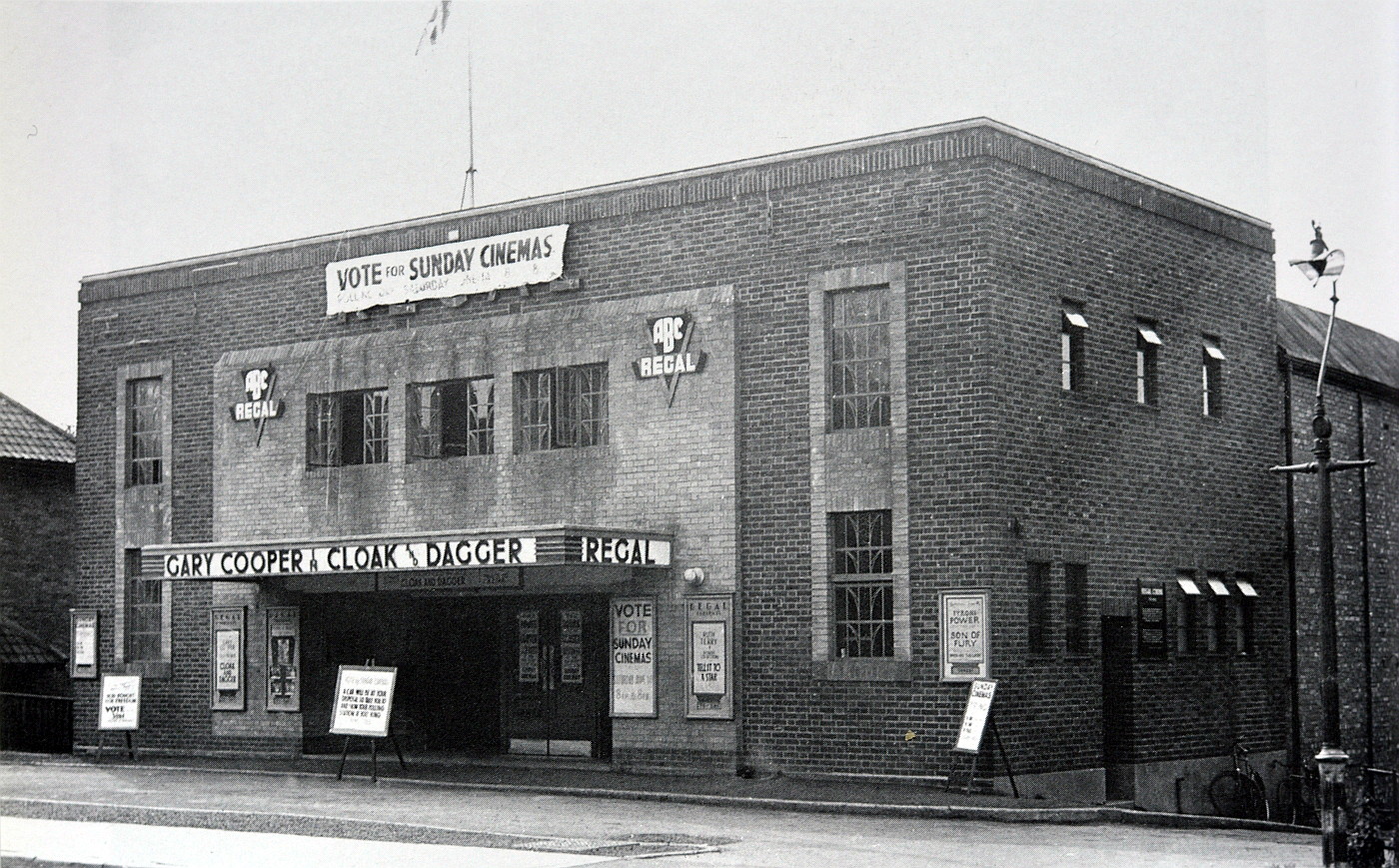
|
Tring’s last purpose-built cinema, THE REGAL
――――◊――――
FOREWORD
The word “cinema” has different meanings depending on context.
It can refer to the production of films as an art or industry, and
can also apply to a theatre where films are shown for public entertainment (also referred to
affectionately as
“picture houses”, “flicks” and “fleapits”). This paper is
mostly about the latter, Tring’s picture houses.
For many years the
townsfolk of Tring were able to visit a purpose-built cinema in the
town, there to enjoy the film industry’s depictions of drama,
romance, horror and science fiction, which judging from old
programme advertisements included some of cinema’s finest moments.
Then, in February 1958, public film shows ceased when the REGAL
closed suddenly and unexpectedly. The cinema was reopened by
another proprietor shortly after, but closed again in March 1960, bringing to an end
almost fifty
years of cinema in Tring ― or was it the end?
The account that follows comes for the most part from
contemporary newspaper reports and advertisements. It tells the history of Tring’s
cinemas beginning with the earliest, the GEM, then
progressing to the present day with a lengthy hiatus
between the closing of the REGAL and the
opening of the TRING CINEMA, a pop-up community cinema based
in the Nora Grace Hall.
My thanks go to local historians
Wendy Austin, Jill Fowler and Mike Bass for the use of their papers on this subject.
I have also used some unattributed documents, so my thanks also go to those unknown authors.
Ian Petticrew
June 2019
For my U3A movie talks, go to . . . .
CINEMA IN TRING
- Part 1
CINEMA IN TRING
- Part 2
――――◊――――
CONTENTS
TRING’S FIRST MOTION PICTURE SHOWS
THE FIRST GEM
THE
SECOND GEM
THE EMPIRE
MEMORIES
OF THE EMPIRE’S PIANIST
THE TALKIES
THE GAIETY
THE REGAL
THE MASQUE THEATRE
TRING’S POP-UP COMMUNITY CINEMA
――――◊――――
TRING’S FIRST MOTION PICTURE SHOWS
When Tring acquired its first cinema over a century ago, many in the
town were already familiar with motion picture or “movie” shows as they
were later known. The
earliest report I have seen of motion pictures being shown in the
town was
at the Victoria Hall on Wednesday 8th May 1897, but on that occasion
what was shown was not reported. However, the Bucks Herald
did give its readers details of the “animated photographs”
– also referred to as a
“cinematograph exhibition” –
that were shown at the Victoria Hall on the
22nd March 1899:
“THE CINEMATOGRAPH.
― Under the auspices of the New
Mill Baptist Sunday School, Mr. Andrew Dron gave an exhibition of
photographic transparencies and animated photographs, at the
Victoria Hall, on Wednesday. Part 1 consisted of
transparencies illustrating ‘From Greenland’s icy mountains.’ A
cinematograph exhibition formed the second part, amongst the
incidents reproduced being:― Negroes
taking morning dip, falling wall, Guards marching through Hyde Park,
cartoonist sketching (humorous), fire call (Southwark Bridge Road),
Dragoons crossing river on horseback, Launch of the ‘Albion’
(Blackwall disaster) [YouTube],
artillery practice, phantom ride in front of engine [YouTube],
high diving in swimming bath, sleeping groom (humorous), express
train traffic (London & North-Western), rough sea, arrival of train
in station [YouTube]
launch of an Italian ironclad, snowballing, Queen Victoria passing
through Hyde Park, and several others.”
――――◊――――
THE FIRST GEM
In the following years cinematograph exhibitions took place occasionally.
Then, in
November 1912, Mr. P. J. Darvell of Chesham, representing the
Enterprise Cinema Syndicate, opened Tring’s first cinema, the GEM.
This “picture palace”, as it was called, was located in the Unity Hall above what was then the Tring Co-operative
Society’s store at No. 60 High Street (now Olive
Limes Indian Restaurant). The Hall, which could accommodate 300
people, was often used for staging plays and concerts. The Bucks Herald informed
its readers that the
building had been altered to provide a
second staircase and additional exits, and that there were to be
twice nightly entertainments, know to later audiences as the “first
house” and “second house”. Writing in the November 1967 edition of Hertfordshire Countryside, Hayward Parrott had this to say about
the GEM:
“NOVEMBER 1912
was a great month for Tring. The GEM picture palace opened its
doors for the first time to the waiting crowd. The hall was
over the Co-operative stores in the High Street. Mr. J. Bearinstain, who now lives in Aylesbury, was manager and
projectionist [1] at one and the same time. Mrs. Jennings was the
pianist. At the other end of the scale was Frank Harrowell,
the chocolate boy. Mr. Harrowell and his wife still live at
Wingrave Road, New Mill. Mr. E. Brackley, of Tring, was also
on the payroll as a boy.
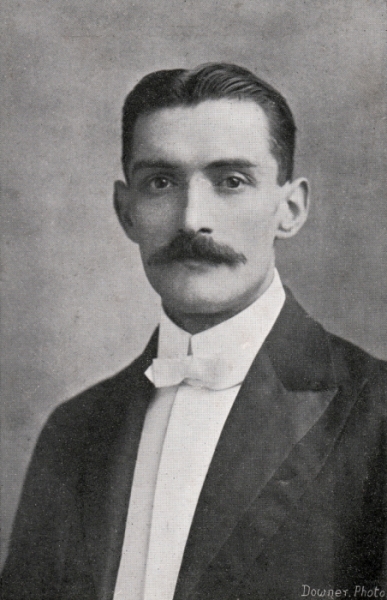 |
|
J. Bearinstain, Manager and Projectionist. |
Moving films were not new to Tring people, for before the start of
the GEM they had watched travelling shows three days a week at the
Victoria Hall. The GEM charged from threepence to one shilling
for its seats at evening shows. On Saturday afternoons patrons
merely paid one penny. Most of the films were Vitagraph
productions, [2]
with such stars as John Bunny, a comedian, Maurice
Costello, a detective, Flora Finch and Evelyn Turner. Charlie
Chaplin appeared as a policeman in Keystone comedies before his rise
to fame and fortune. ‘Quo Vadis’ [YouTube]
was seen at the GEM in 1913.

Advertised as
“The GEM Electric Picture Hall.”
Note, tea served free to those in 6d., 9d., and 1/- seats.
Mr. Bearinstain well remembers these pioneer days in Tring.
Technical hitches produced rude sallies from the audience.
Improvisations were made to keep the picture on the screen or
failing that to keep the audience in good humour! On Tring
Show day someone from the GEM was on location getting shots with a
movie camera. People flocked to see the film, hoping to catch
a glimpse of themselves as they flickered across the tiny screen.
Mr. Frank Harrowell was a boy of twelve when he walked the gangway
at the GEM with his tray of sweets and chocolates. He was paid
three shillings a week plus commission of a halfpenny in the
shilling. He also operated the sound effects to imitate the
noises of charging horses, rifle fire and cannons during the showing
of the epic The Battle of Waterloo and other war scenes. The late
Mr. Fred Budd, then a boy from the Church Lads’ Brigade, sounded the
bugle.”
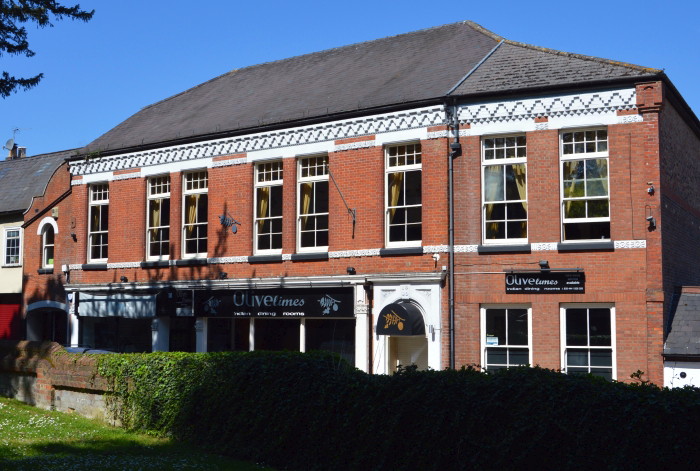
The first GEM cinema was located on the upper floor of No.60, High Street.
Built in 1880 by the Tring Co-operative Society, the Co-op store
remained on the site until the 1980s.
――――◊――――
THE SECOND GEM
The first GEM prospered sufficiently –
trade no doubt being boosted by the large numbers of troops
based at Halton Camp – to encourage its proprietor
to invest in a larger, purpose-built cinema, for on the 5th February
1916 the
Bucks Herald announced that:
“NEW PICTURE HALL.
― Mr. P. J. Darvell, of the GEM
Picture Hall, has acquired a very fine site in the Western-road
― ‘Fairfield’
― and is starting at once to build
an up-to-date picture and concert hall. The plans are now
before the Council, and it is hoped that the building will be
completed in five or six week’s time.”
Bucks Herald, 5th February, 1916
Construction of the new picture palace was financed by a company set
up for the purpose, The Tring Picture and Concert Hall Company Limited.
The company
was registered on the 14th March 1916 with a capital of £2,250 in £1 shares,
its three directors being A. Hutchinson, P. Dyer and P. J. Darvell
(of 10 Akeman Street, Tring). War work appears not to have hindered
construction, for by the beginning of July the building was nearly
complete:
“THE PICTURE PALACE.―The
new Picture Hall in Western-road ― which has been erected by a
syndicate of which Mr. P. J. Darvell, who for three-and-a-half
years has conducted the GEM picture Hall in another part of the
town is resident proprietor ― is approaching completion. It is
hoped to open it during next week. The building occupies a
capital site on the Western-road, and will provide accommodation for
an audience of 400.
Special attention has been paid to the ventilation, which is of the
most up-to-date and effective character. The building is of
brickwork and every precaution in the way of fire exits and fire
curtains has been provided.
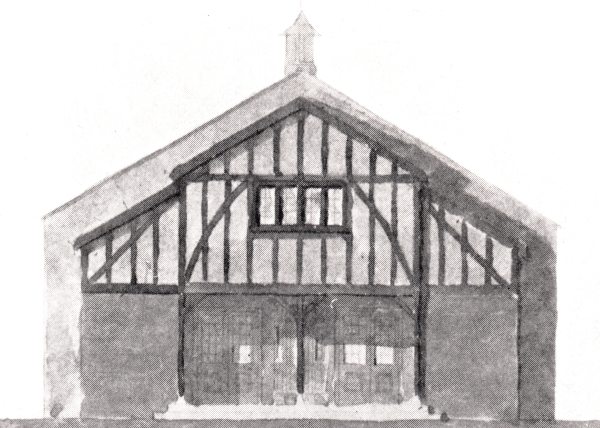
A sketch of the front of the second GEM cinema.
The pay box is on one side of the entrance and the manager’s office
on the other. The entrance is of oak, on stone plinths, and
the front of the building will be finished in timber and half-cast,
a style which is so popular locally. The building will be
furnished throughout with tip-up chairs and the inclined floor will
give a good view of the screen to all parts of the house. The
plans were drawn by a local architect, and every effort has been
made to ensure the convenience and comfort of patrons.
Arrangements have been concluded for the supply of exclusive films
to the Hall.”
Bucks Herald 15th July 1916
It should be remembered that Tring did not have mains
electricity at the time
―
that came in 1926
―
so the interior of the building was probably lit by gas. It was also
an age when many smoked, hence the report’s emphasis on the
importance of ventilation of
“the most up-to-date and effective character”
and fire protection.
Life in the projection room [3] was potentially
dangerous, for the nitrate based film ―
essentially a solid form of nitro-glycerine ―
then in use, was highly flammable. If nitrate film combusts,
the resulting fire generates its own oxygen creating a flame that
cannot be extinguished. It can burn underwater; it can burn
beneath a fire blanket; it burns until the celluloid is gone and any
attempt to smother it creates toxic fumes.
Following numerous cinema fires caused by this unstable film, the
Cinematograph Act [4] was introduced in 1909 requiring movie
projectors to be placed in a projection room with wall coverings
made from asbestos and fire
shutters over the projection ports. A further Act in 1922
[the
Act] required cinemas to take other safety precautions. |
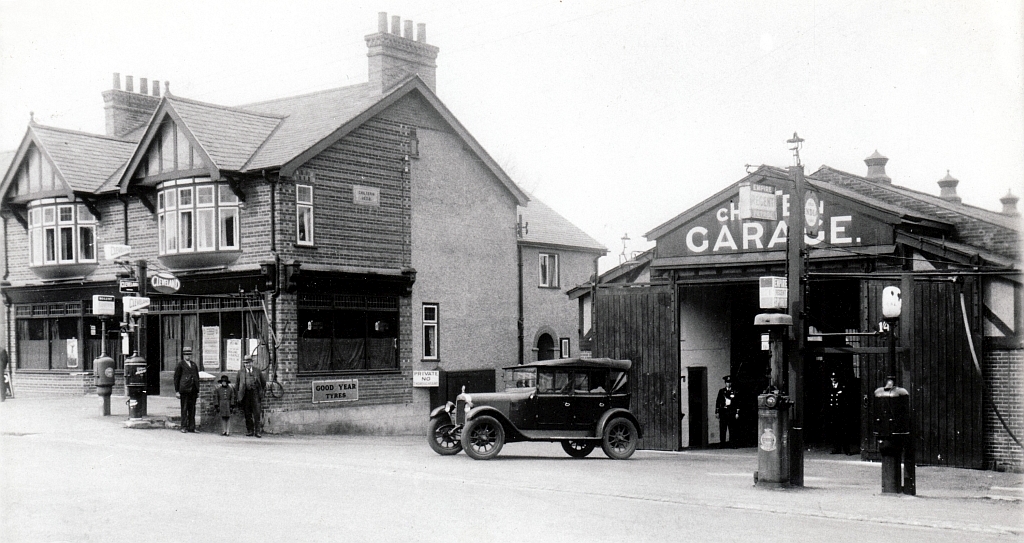
|
The second GEM cinema in its latter days serving as the Chiltern Garage at No. 46 Western
Road.
The building was demolished in the early 1930s when the
site became a bus depot.
The new GEM occupied a site in Western Road opposite Henry Street,
which today is the premises of Tring’s Royal Mail sorting office.
A report of the time (unattributed) had this to say about the new
enterprise, which had . . . .
“. . . . a frontage of 100 ft. to that main thoroughfare of
Tring. It will accommodate 500 persons in 3d, 4d, 6d and 9d.
seats, and has boxes at 7s. 6d., each, with continuous performances
from 6 till 10, equivalent to two houses nightly. In its
construction ample provision is being made for variety turns, which
would be a welcome feature. Mr. Darvell is no stranger in
Tring, nor to the cinema business in this town. He was the
first to start a place of this character here, and has successfully
run the Gem Cinema at the hall of the Co-operative Society for the
past three years, and during the last twelve months he has also
carried on the Halton Camp Cinema, [5]
specially erected for the
entertainment of the troops there stationed.
The new GEM opened on the 1st August 1916:
“Owing to one or two inevitable delays Mr. Darvell was unable to
open on Saturday as announced, but by Tuesday all obstacles had been
overcome, and a very encouraging start was made. Some work yet
remains to be done in the way of interior and exterior decoration,
but when completed the Hall will evidently by very comfortable and
attractive.
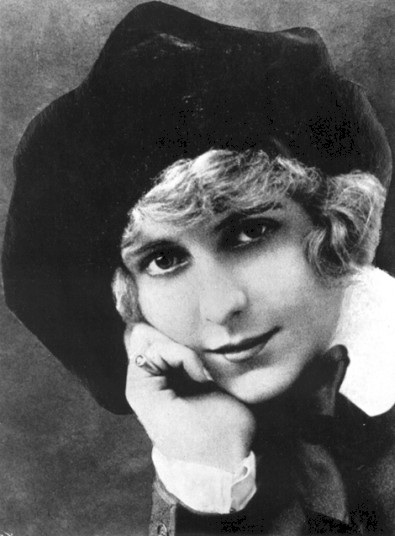 |
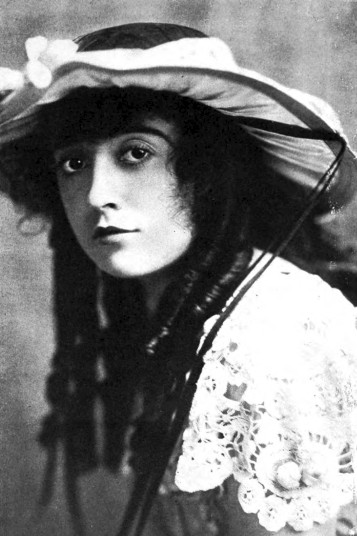 |
|
Pearl White
star of Exploits of Elaine,
photographed in 1917 |
Mabel Normand
star of Lost and Won,
photographed in 1915. |
The management have secured some splendid films, and the popular ‘Exploits
of Elaine’ [YouTube]
has been followed with great interest. Other attractions this
week have been ‘Lost and Won’, [YouTube]
a drama with strong supporting interest, and ‘Those College Girls’,
and an exclusive Keystone picture.
Mrs Jennings, who was so long with the old GEM, continues her work
at the new building, and her pianoforte performances were this week
effectively supplemented by a violinist.”
Bucks Herald 5th August 1916
In March 1917, Darvell’s name, as the cinema’s “proprietor”, is
replaced in GEM programme
advertisements by that
of it owners, The Tring Picture & Concert Hall Co. Ltd. This
may have been due to him having taken on the management of the nearby
military camp cinema at Halton (later to become R.A.F. Halton),
but there were several later references to him in the local
newspaper.
During March 1917, in his role as manager of the Halton Camp Cinema,
Darvell was
prosecuted by H. M. Customs & Excise for non-payment of
Entertainment Tax, [6] the Prosecution claiming that “the defendant
had given a considerable amount of trouble over the matter.”
A ruling was made against him in the sum of £12 8s 8d unpaid tax
with £1 6s 6d costs, but of more serious consequence was the injury he sustained around this time in a road traffic accident:
“On Friday evening Mr. P. J. Darvell, manager of the [Halton]
Camp Cinema, was the victim of a serious accident resulting in
severe contusions of the face and forehead, and concussion.
Mr. Darvell was cycling, and when near the Camp Post Office was
about to pass a transport standing on the side of the road.
The mules of this vehicle were somewhat restive, and made a sudden
turn towards the centre of the road. The driver jumped down
and ran to seize the animals’ heads, when most unfortunately
Mr. Darvell collided with him, and was thrown heavily to the ground.
Assistance was speedily forthcoming, and it was soon evident that he
was in a serious condition, being quite unconscious.”
Bucks Herald 17th March 1917
Darvell was taken to the Royal Bucks Infirmary where he made a
recovery. Later in the year he was called to appear before a
military tribunal to determine whether he should be exempt from
conscription into the armed forces. During the hearing Darvell, then employed as a munitions worker, explained that he had been
blinded in one eye, the result of a recent accident. And with
that Tring’s first cinema proprietor disappears from the scene,
followed shortly after by the GEM.
An article in the Bucks Herald (9th June 1917) announced that The Tring Picture & Concert Hall Co. Ltd.,
owners of the GEM, had been summoned by the Berkhamsted Petty
Sessions for non-payment of £13-2s-6d in rates. During the
hearing The Collector informed the bench that
“the GEM picture house at Tring was closed.” On the 4th May 1922 the London Gazette announced that the The
Tring Picture and Concert Hall Company Limited, owners of the GEM,
had been voluntarily wound up. Then in
February 1924, by order of the mortgagees, the building and site
(No. 46 Western Road) comprising
¾ acre of land was sold by auction.
It was then used, first, as a garage,
then as a bus depot (Chiltern Bus Services, later the London
Transport Passenger Board), then by United Dairies, and it presently
plays host to a Royal Mail sorting
office.
――――◊――――
THE EMPIRE
The GEM would likely have been a commercial success had
it not been for the opening a few days earlier of a rival cinema . .
. .
“THE
COUNCIL’S
COTTAGES.―A
letter was read from Mr. James Honour, saying that he had sold four
cottages in Akeman-street to a Cinema Company. As the company
required the site, the tenants would have to get out. He asked if
the Council would allow them to move into the Council cottages. They
were good tenants and respectable.―The
Council regretted that they were unable to accede to his request.
The question had been raised before, but they could not do it. It
was contrary to the conditions under which they held the property.”
Bucks Herald 12th February 1916
The cottages were freed of their tenants, demolished, and building
pressed ahead on the vacant site. By July construction was
almost complete:
“THE
NEW
CINEMA.―The
new Cinematograph Theatre in Akeman-street, now nearly completed,
will be opened in the course of the week. The building has an
imposing front designed in the Georgian style, and the interior has
been very tastefully decorated in the Adams period. The
ventilation is of the most modern principle, with Boyle’s patent
roof ventilators, and, in addition, an electric exhaust fan.
The heating will be by means of gas radiators, and other features,
such as tip-up seats, are included to add to the comfort of
theatre-goers.
Two dressing rooms are placed in conjunction to the stage, which is
designed for variety turns of a refined class.
No expense has been spared to make this theatre the last word in
Cinemas. The Building has been carried out by the well-known
firm of J. Honour and Son Ltd., for a local syndicate, from the
plans and under the personal supervision of Mr. Fred Taylor
A.R.I.B.A., architect, Aylesbury.”
Bucks Herald 22nd July 1916
The EMPIRE was a purpose-built cinema designed to seat 250 people
plus a small balcony with 64 seats. The architect designed the building to the requirements of William
Charles Taylor, who was determined to open before the new GEM in
Western Road; in that he succeeded, for the EMPIRE opened on Saturday
29th July 1916, two days before the GEM.
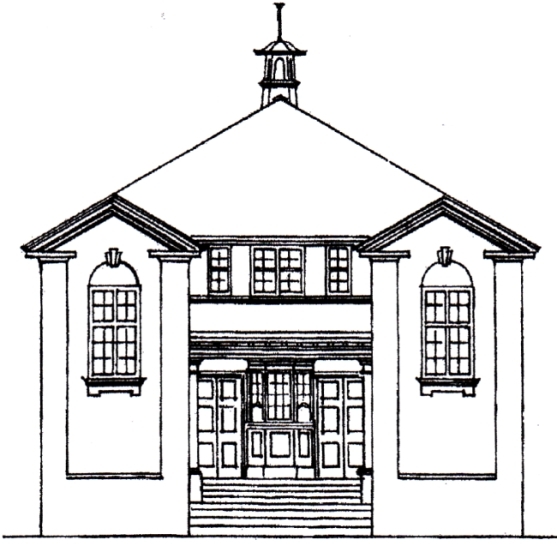
Front elevation of the EMPIRE, Tring, as built.
A local resident
recalls that at the EMPIRE’s opening the film kept fading on the
screen. This was because the projector was powered by a dynamo
driven by a gas engine and the belt drive
connecting the two kept slipping off the
dynamo
(Tring had no mains electricity
until 1926, hence the need for a generator
set). If the film broke more than three times each
customer received a
free ticket to see it again the following night, although most people
used the complimentary tickets to see a new film.
“The EMPIRE, in Akeman-street, opened on Saturday afternoon with
a special performance in aid of the Red Cross Funds. This was
under the patronage of Mrs. J. G. Williams and other local ladies,
and was largely attended. The interior of the hall, decorated
in a scheme of red, presents a bright and comfortable appearance,
and every arrangement appears to have been made to secure the
comfort and convenience of patrons. A special feature of the
building is the spacious balcony, which is provided with an outside
staircase in case of emergency.
On Saturday afternoon Charles Reade’s Cloister and the Hearth
was presented, and in the evening the Drury Lane drama The Derby
Winner. A strong programme was provided for the first
week, including A Rose amongst Thorns, Masks and Faces
[YouTube],
Protea III., and Warmakers.”
Bucks Herald 5th August 1916
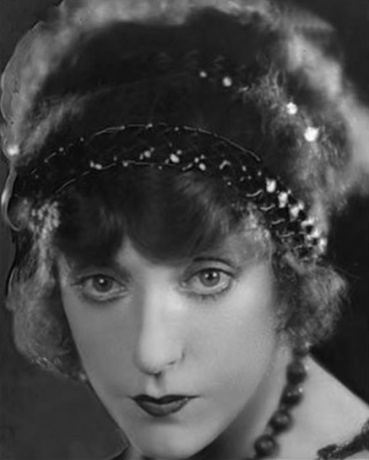 |
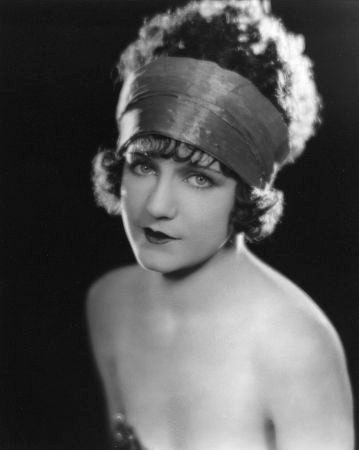 |
|
Annette Kellerman
Australian professional swimmer, vaudeville star,
film actress, and writer. She appeared in several
movies, usually with aquatic themes. As the star
of A Daughter of the Gods (film now lost) [YouTube]
she was the first major actress to appear nude in a
Hollywood production. |
Viola Dana
star of A Rose amongst Thorns. Viola [YouTube]
made her film debut in 1914, later appearing in over 100
films, but she was unable to make the transition to
talkies. She lived to be 100. [YouTube] |
A few weeks later the Herald reported: “The
Empire.―Good business has been done during the week with Anthony
and Cleopatra, one of the most thrilling dramatic pictures ever
shown and which it is stated cost over £40,000 to produce”.
Since cinema tickets at the time cost 3d, 6d and 1/- this must have
seemed to cinemagoers an immense sum of money.
Another film that created a stir was A Daughter of the Gods screened
in 1918. The Bucks Herald, June 15th, was most
enthusiastic:
“A Daughter of the Gods.―This
film was screened at the Empire on Monday, Tuesday and Wednesday to
large houses. The magnitude of the production can only be
realised by the fact that 25,000 people and 5,000 horses took part
in it and the magnificent city, which as a climax was destroyed by
fire, cost no less than £50,000 to build. The management is to
be congratulated on its success.”
The EMPIRE survived its technical teething troubles and for several
years Tring cinemagoers could if they
wished choose between the GEM and the EMPIRE for
their movie entertainment.
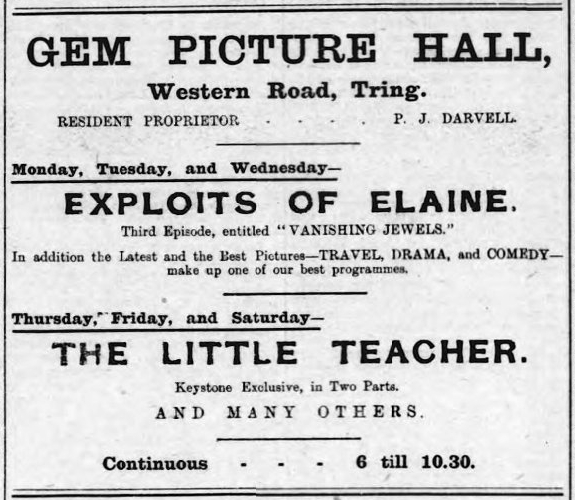 |
 |
|
Pictures showing at the GEM and the EMPIRE, Bucks
Herald 12th August 1916. |
Both cinemas advertised their programmes regularly in the Bucks Herald,
but after April 1917 the GEM ceased advertising while the EMPIRE
advertised less frequently, its adverts pretty much disappearing
during the 1920s. Why,
is a matter for speculation, but a possible reason was the
imposition of Entertainments Tax, [6] a very unpopular
tax introduced in
1916 to help fund the war effort and not withdrawn until 1960!
Under the tax, cinema proprietors were required to collect stamp duty on all
admissions thus increasing ticket prices, so dropping newspaper
advertising and relying on paper posters (example below) affixed to billboards
might have been a necessary economy.
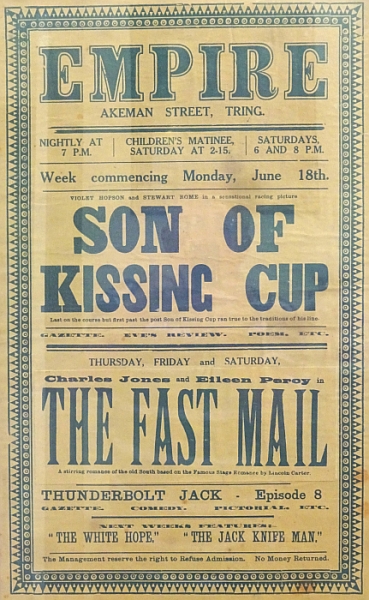
Undated poster for the EMPIRE.
As for the EMPIRE, regular programme advertising did not return to the
pages of the
Bucks Herald until 1930, so it is impossible to say what its
programmes offered cinemagoers during the 1920s, the last decade of
the silent-film era.
However, that term
is a misnomer, for during the silent-film era (from the mid-1890s to
the late 1920s) films were almost always accompanied by
live sound. A pianist, theatre organist, [YouTube]
or even, in large
cities, a small orchestra, would often accompany the films.
Pianists and organists would either play from sheet music or
improvise. Sometimes a person would even narrate the intertitle
cards and, as previously mentioned, make sound effects such as
rattling, banging, clashing of swords, etc. Thus, even before there was technology to synchronize
sound and video, sound in some form was an essential element of the viewing experience.
――――◊――――
Memories of the EMPIRE’s
pianist
“It is quite some time since a seat at the cinema,
a bag of sweets with a fish and chip supper to follow, cost no more
than sixpence. Six old pennies, that is.
|
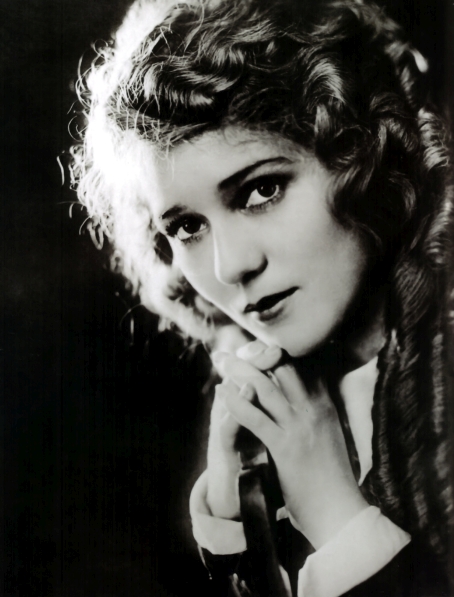 |
|
Mary Pickford
American star of the silent movie era and later a film
producer, Mary found her career fading as talkies became
more popular and she retired from acting in 1933.
She was a co-founder of the United Artists film studio
and one of the original founders of the Academy of
Motion Picture Arts and Sciences, who present the annual
“Oscar” awards. Her career spanned 50 years. |
It is also a few years since stars such as Tom Mix, Harold Lloyd and
Mary Pickford appeared on the silent screen at the Empire, Akeman
Street. One who remembers wistfully those far-off days is Mrs
Alice Turner of 88 Western Road. Few, if any of the younger
generation, would connect this pleasant, homely woman with the golden
years of the silent screen. Yet night after night Mrs Turner,
or Alice Seabrook as she was, pounded her keyboard as the cinema
pianist. She recalls that they were marathons, starting at 6
pm and running until 10.30, relieved only by a five-minute break at
8.15. There were frequent breakdowns in the film, which meant
extra playing. Mrs Turner believes these performances would
have qualified for the Guinness Book of Records for non-stop piano
playing.
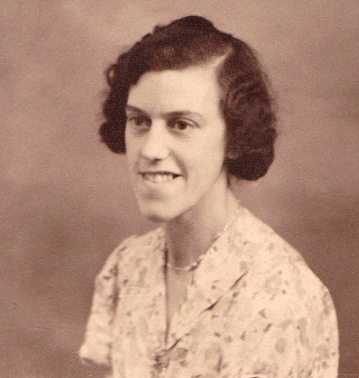 |
|
Alice Turner (née
Seabrook),
pianist at the EMPIRE cinema. |
She recalls that there were often staff shortages and in consequence
she had to issue tickets at the box office, racing from there to her
piano for curtain-up. She also recalls the horde of boys who
would slip into the cinema when queues formed at the box office.
Another recollection is the heating in the cinema, which was a coal
or coke stove at the front of the auditorium. Those sitting
nearby managed to keep warm and some patrons roasted a few
chestnuts. The manager frequently stoked it up and stirred it
with a poker. When this happened, those in the front stalls
were usually covered in ash dust. It was often so cold that
Mrs Turner wore Wellington boots and fingerless mitts at her piano.
Sometimes film-goers wore overcoats and all kinds of protective
clothing.
There were other pianists who played at the EMPIRE.
Outstanding among them, in Mrs Turner’s view, was the late Stumpy
Cato, a handicapped genius who could swing it with the best, supply
music for the most tender love scene or indeed for any situation on
film. Born without feet, this versatile performer was assured
of generous applause wherever he played.”
Bucks Advertiser 22nd March 1974
Some older residents of the town recalled the auditorium
occasionally being sprayed with a flit spray gun, although
whether this was to freshen up the atmosphere or deal with bugs
(cinemas weren't christened “flea-pits” for nothing) isn't recorded.
――――◊――――
THE TALKIES
In June 1930 the “talkies”
came to Tring . . . .
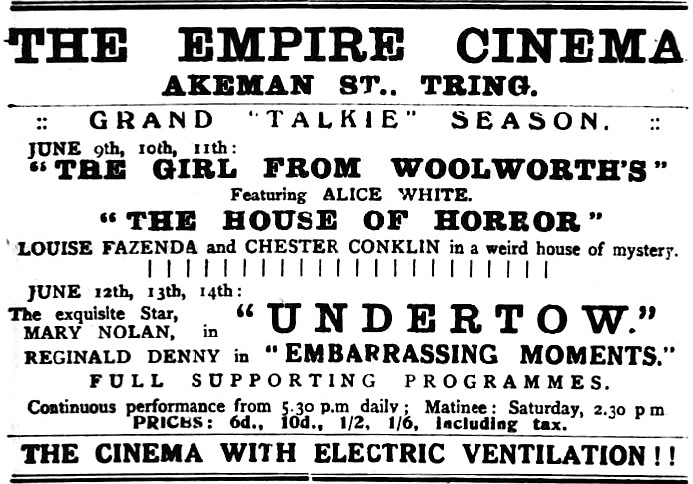
The Grand “Talkie” Season commences at the EMPIRE,
9th June 1930
“THE EMPIRE CINEMA, Akeman-street, Tring,
has gone over to ‘talkies’ [7] without any interruption in the usual
programme. ‘The Kinevox’ All-British Sound System and two
first-class British projectors have been installed and patrons are
assured of an entertainment equal to West End presentations.
The auditorium has been reconditioned and equipped with electric
ventilation; the cinema is also under entirely new management.
The programme for next week will beat the summer sun for brilliance.
On Monday, Tuesday and Wednesday Alice White appears in The Girl
from Woolworth’s and Louise Fazenda and Chester Conklin in the
House of Horror. On Thursday, Friday and Saturday
Undertow [Youtube],
featuring Mary Nolan, will be presented, while Reginald Denny will
be seen in Embarrassing Moments.”
Bucks Herald 6th June 1930
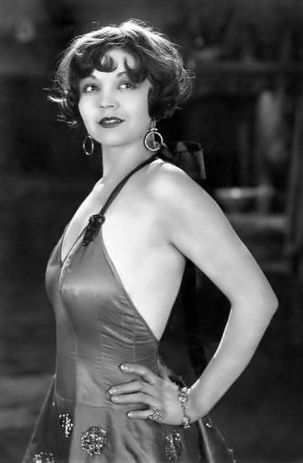 |
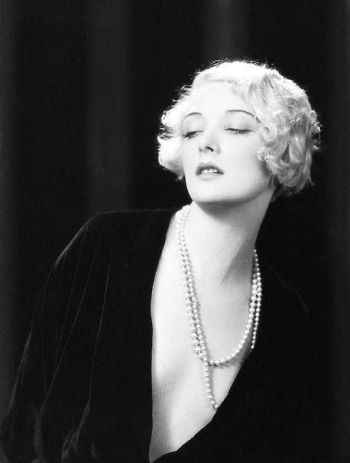 |
|
Alice White (left) starred in The Girl from
Woolworth’s,
and Mary Nolan (right) in Undertow |
The EMPIRE Cinema was packed to excess on Thursday evening week,
when the ‘talkies’ were formally inaugurated . . . . The actual
ceremony of ‘switching-in’ the talkies was performed by Mr. J. Bly,
Chairman of the Urban District Council. Capt. Collins, the
licensee of the cinema, welcomed Mr. Bly and thanked those present
for their patronage.
Mr. Bly said the talkies were a new era in films. Although
they had them for some time, they had not been quite the success
they wished. Now, however, success was achieved. The
public would be glad to know that the greater part of the films and
the of the machinery used at that cinema was British. (Applause)
They were proud to know that Britain could turn out such machinery
as was used there. Not many years ago we used to be very
pleased with a magic lantern show. The pictures had become
very great since then and had a great future before them, both from
a moral and entertainment standpoint. He congratulated the
management on what they had achieved and wished them continued
success, expressing the hope that the tone of the pictures would be
of a high standard. He then pressed the switch controlling the
apparatus, the lights disappeared, and with a plain ‘Universal News
calling’ the talkies commenced with current news items.
Following the news, an all-talking comedy, A Hint to Brides,
caused much amusement.
Bucks Herald 1st August 1930
――――◊――――
THE GAIETY
|
Former Tring resident Ron Kitchener jots down his memories
of trips to the Gaiety . Not wonderful poetry, but it
paints a picture nevertheless . . . . |
|
A cinema — so
it was called,
For what else could you call it?
Dimly lit with shades on gas
’Twas more by name a flea pit!
Not so sumptious rows of seats,
A balcony up above us,
Front two rows the hard up seats,
Back rows, just for lovers!
Painted murals in soft glow,
And shimmering on the wall;
Sexy maidens, scantily clad,
And nearly six feet tall!
Seats quite hard but packed to fill
The body smells to poo,
Spraying air with flit-like guns
The usherette to do!
Spray it here and squirt it there,
Over here please — too!
Not DDT or Keatings Dust,
But like the smell in loo!
Rose petal or carnation
It always smelt the same,
Forget the pong — the film was on
We knew the stars by name.
John Boles or Myrna Loy were two,
“Red Shadow” —— “Desert Song”
By now the actual “talkies,”
Were overcoming pong!
Tom Mix, Ken Maynard, ‘Hoot’ Gibson too —
Cowboys filled the flicks!
The celluloid film oft caught aflame,
’Twas quite a box of tricks!
Bela Lugosi, Karloff — Who?
They sounded strange by name;
Dracula, Frankenstein. You know!
Blood curdling bats or brain.
Charlie Chaplin, ‘Buster’ Keaton,
Harold Lloyd — the tops.
Comedy and thrills galore
And even ‘Keystone Cops’.
Tho’ most were simple silent films,
Sub-titles at the bottom,
To us, they were such gems of screen
Some good, some just so rotten!
Cheers and moans just filled the air
And sulphur fumes did choke;
For heating with combustion stoves,
Filled air with stinking coke.
Anytime, and during film,
Betwixt this job — or that
The Manager was the stoker
He shovelled and he spat!
Sometimes when silence hit the screen,
No organ rose to please;
On came the senior usherette
To tinkle ivory keys! |
No sweets or ice cream sold to you,
You bought them — next door shops
Coconut toffee, vinegar flats
Some sherbert and corn pops!
Peanuts too, sold in their shells,
Not salted as today;
They littered floor beneath the seats,
You walked a crackly way.
This was the real adventure,
The likes had not been seen
To open up the way ahead,
The frontiers in between.
‘A’ films, ‘U’ films — categorised too,
They didn’t bar the way;
Such various ways to see the show,
Perhaps best — not to say!
Hurrah for senior usherette,
And she sold tickets too;
No demarcation lines those days —
So many jobs to do!
Al Jolson packed the house to full,
’Twas called “The Singing Fool”,
All ‘Black Mammy’ songs to sing,
The price — I can’t recall!
Two films to fill the programme,
Twice weekly for a change
From love to crime, or westerns,
Who cared — with such a range.
The greatest film that I recall,
The Big Cage was its name:
The seats and aisles were jam packed full
A circus film — quite plain!
Such times were hard but never glum
And money tighter still;
But all in all we struggled by,
Our minds and plates to fill.
As you sit and watch today
With Hi Fi and T.V.,
Have you seen, as we did see
That yesterday’s mystery!
It’s all a dream of yesteryear,
Of simply what has been:
But it was real to us you see
And could be on your screen.
We laughed and cried, much more than now,
Because of simple things:
To search to find the better ways —
The pleasure that it brings.
So when you go to cinema,
Or watch the video;
Just enjoy, all that you can
It’s all part of — you know!
The Gaiety closed — The Regal came,
So up-to-date — to pass;
They simply played their part,
Like us — nothing seems to last!
AND they played GOD SAVE THE KING! |
|
Ron Kitchener |
By August 1931 the EMPIRE had been renamed THE GAIETY, and as such the cinema continued in
business until 1937, its last advertised film programme appearing in
the 23rd April edition of the Bucks Herald. Despite the
lack of programme advertising the cinema appears to have continued
in some form, for positions for a cashier and two
attendants were advertised in August. There followed a couple of charity
functions held on the premises following which the GAIETY disappears from view without, so
far as I can trace, an obituary. I presume it suffered the
fate that befell its former
competitor the GEM, that the town
could not support two picture houses. Thus, it became a matter
of the survival of the fittest, a contest from which the newly built REGAL
emerged victorious.
That said, the GAIETY’s last years are not without interest.
During this period the cinema changed hands several times, the first being in
1929 when, in a somewhat inflated announcement, the Herald’s
readers were advised that the
EMPIRE (as it then was) was under new management . . . .
“. . . . the EMPIRE CINEMA at Tring, is meeting the public taste
and demands in every possible way. Daily performances from
6-10 p.m., with a Saturday matinee, are being attended in ever
increasing numbers. Considerable discrimination is being shown
in the choice of weekly programmes and the amenities of the cinema
are now such as to make a much wider appeal than before.
Weekly programmes regularly appear on our Tring page and are being
followed with interest.”
Bucks Herald 13th December 1929
In July
1936 the now renamed GAIETY was again taken over, on this occasion by Smith’s Cinemas of
Southampton Row, London. Shortly after, the town council approved plans
for dressing-rooms and an extension to the stage, which suggests
that the new owners intended to branch out into theatre production:
“The GAIETY was taken over by Smith’s Cinemas, of London, last
week and was gaily decorated for the re-opening with bunting and
coloured lights. The audience was most enthusiastic and seemed
to approve thoroughly the programme that was presented to them.
Work is now under weigh of adding a large stage, fire-proof curtain
and dressing rooms, in order that reviews might be staged.
This is being carried out by Messrs Noakes and Palmer of Chesham.
Other alterations include the reseating of the balcony, and it might
be added that all this work is proceeding without any interference
to the business or comfort for the audiences.”
Bucks Herald 31st July 1936
Smith’s Cinemas also announced their business policy:
“It is the
policy of the GAIETY THEATRE to show entirely exclusive programmes,
none of the pictures have been shown previously in any part of the
district. New equipment is being installed by Sound
Installation Services Ltd., and the pictures will then be the most
life-like possible, for the new talkie set is the very last word in
modern efficiency . . . . Messrs. Smiths Cinemas, who now control
the GAIETY, beg to thank those who have sent messages of goodwill
and approval, and assure all that the popular Mr. Alan Smith will
continue as manager, so that continuous improvement is assured.
The Company’s slogan ‘always a good programme at the GAIETY,’ is
daily exemplified. Messrs Smith’s Cinemas are contemplating the
erection of two new cinemas in adjacent areas, for the better
displaying of pictures for which they have exclusive rights.”
Bucks Herald 14th August 1936
The installation of
the new ‘Synchosound’ talkie set at the GAIETY CINEMA has been
completed, and patrons are now assured of getting the best possible
projection and reproduction of the films shown. The additions
to the cinema are nearly complete, and when they are finished the
GAIETY will be one of the best halls in the county.”
Bucks Herald 21st August 1936
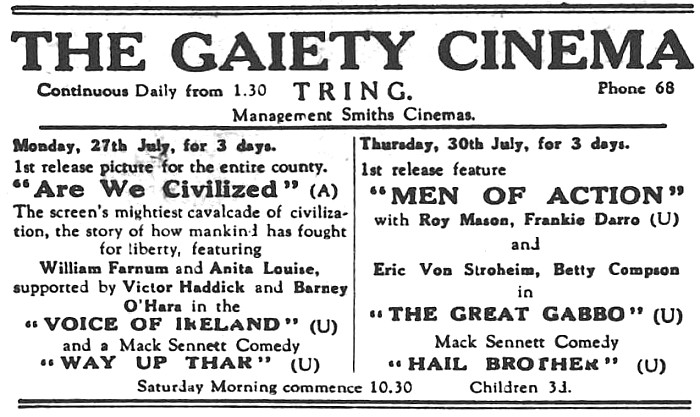
The first GAIETY programme under Smith’s Cinemas, Bucks Herald,
24th July 1936.
|
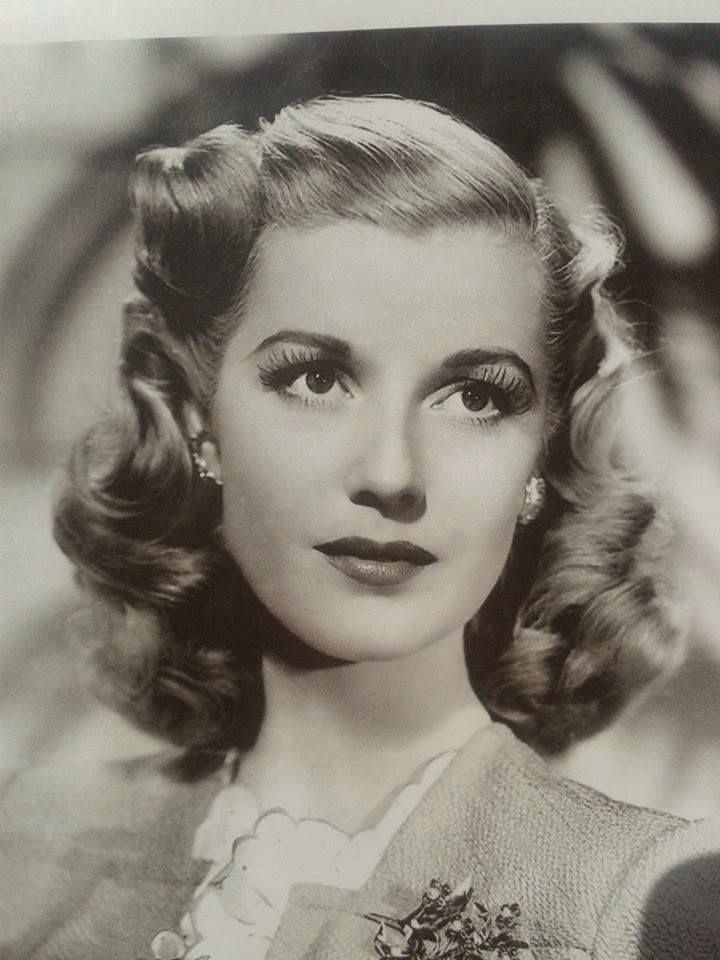 |
|
Anita
Louise
star of Are We Civilized? The film made a veiled attack on Adolf Hitler,
but the story did not make for a good movie.
Often described as one of the cinema’s
most fashionable and stylish women, Louise had delicate
features and blonde hair, with ageless grace, which saw
her through 30 years in film acting. |
Plans for the GAIETY to move into theatre production led to negotiations with a local amateur dramatic
group, the Vale Players . . . .
“Messrs Smith’s Cinemas announce that simultaneously with the
completion of the new stage and dressing rooms, some interesting
stage items will be included with the first class picture
programmes. The Vale Players, Tring’s own excellent amateur
dramatic society, have joined forces with the GAIETY management and
their new production Once a Gentleman, which is now in rehearsal,
will shortly be presented at the GAIETY. Great local interest
centres around this important entertainment and special credit is
due to the energetic and enterprising secretary, Mr. Francis L.
Angell, and to the Society's popular producer, Mr. Oswald E. Bussell.”
Bucks Herald 4th September 1936
. . . . but nothing came of their discussions, for Once a Gentleman was
performed at the Victoria Hall, as was the
group’s following production, The Two Mrs Carrolls.
It seems that at some time between September 1936 and February 1937
ownership of the GAIETY changed hands again, for the
1937 season began with a
“Grand Re-opening” and an announcement that the cinema was
again under
“entirely new management”.
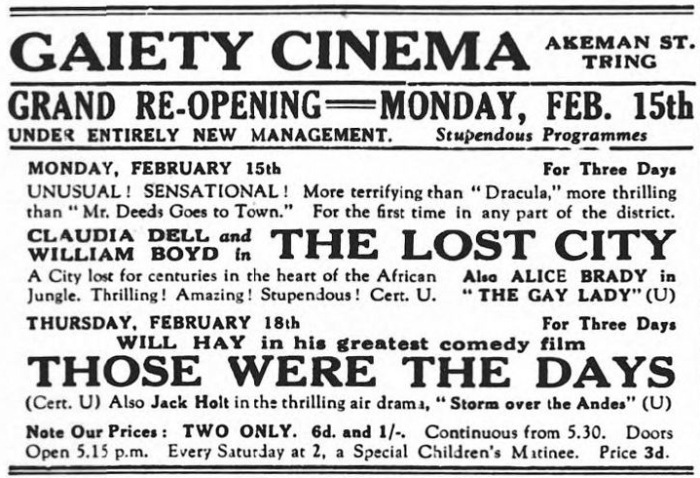
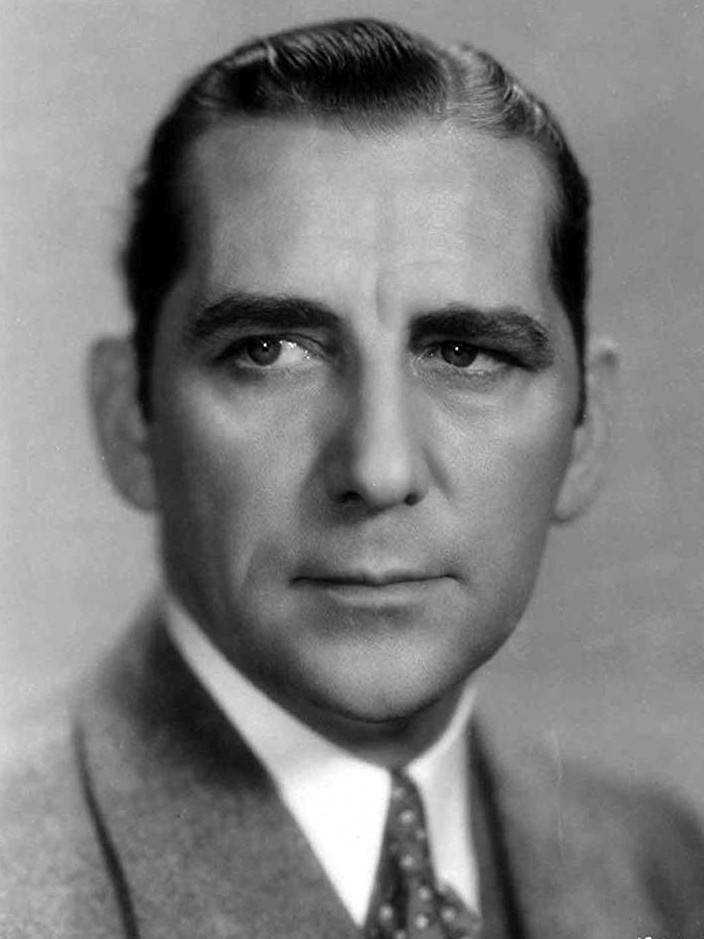 |
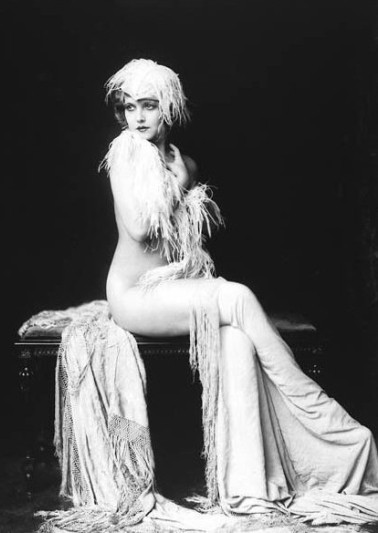 |
|
William
“Stage” Boyd and Claudia Dell, stars of The Lost
City.
Boyd adopted the name
“Stage” (prior to movies he had worked as a stage
actor) to avoid confusion with the other (and more
famous) William Boyd, known to many
through the 52 episodes of the
Hopalong Cassidy
western television series.
“Stage”
Boyd died at the age of 46 from a variety of ailments
related to alcohol and drug abuse. Claudia Dell was an American showgirl and actress, whose
promising film career faded during the 1930s when she was
reduced to playing minor roles. Her later career was
spent in radio and television, and as a modelling
instructor. |
But the new owners were no more successful than
their predecessors, for the final reference to the GAIETY as a cinema
appeared in the 19th
November 1937 edition of the Bucks Herald, where it was
reported that a Remembrance Festival had taken place on Armistice
Night comprising community singing, accompanied by a band,
followed by a newsreel and a feature film, Men of Yesterday.
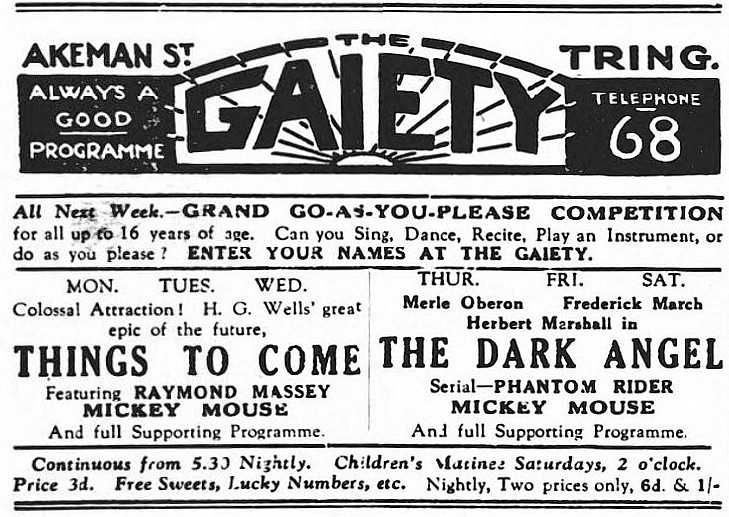
One of the GAIETY’s last advertised
programmes: Bucks Herald 9th April 1937
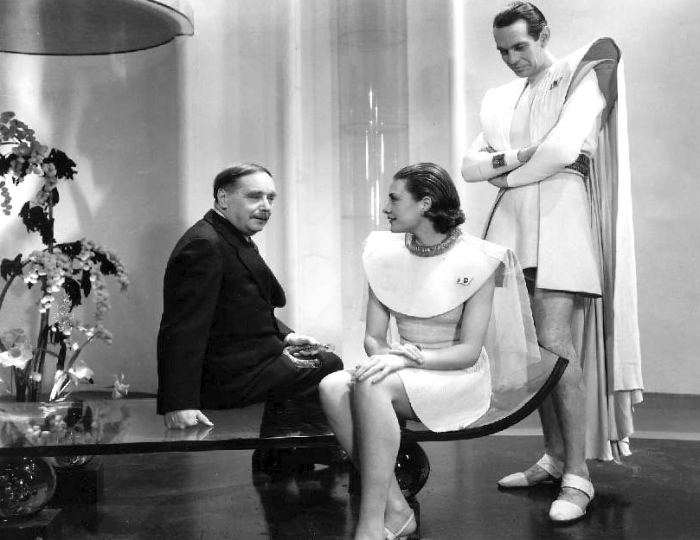
H. G. Wells on set in Things to Come, with Margaretta Scott and
Raymond Massey.
In later years Margaretta Scott
and
her Pekingese, Tricki Woo
(see below) became know to millions of television viewers in her
role as Mrs. Pumphrey in the long-running BBC series
All Creatures Great and Small.
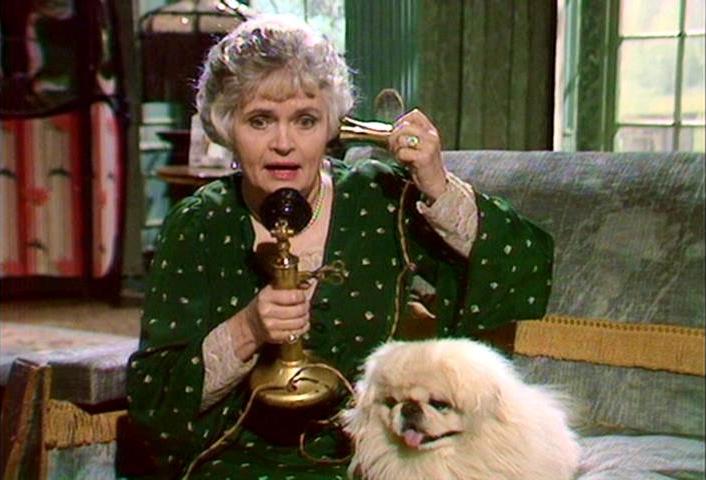
There is no further reference to the GAIETY in the press until
December 1939 when the building was advertised to let, as being “suitable for factory or storage
purposes”. In January 1947 the Bucks
Herald announced that the cinema building was to become “a
small factory for turning out high grade
toys”.
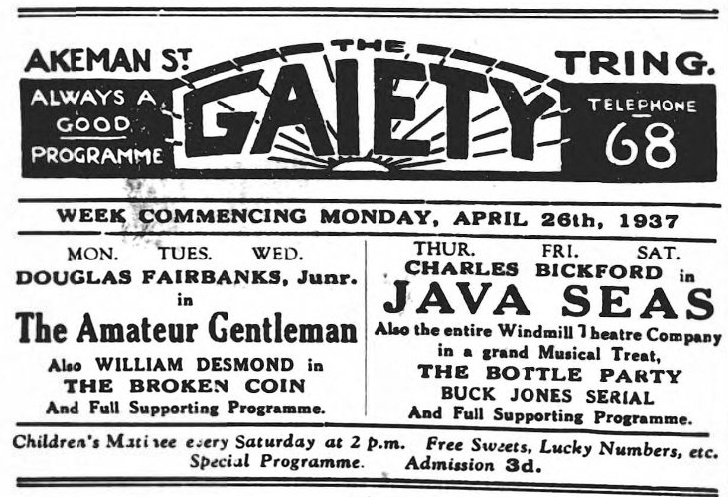
The GAIETY’s
last advertised programme, 23rd April 1937.
The GAIETY, somewhat altered, still
stands in Akeman Street having the distinction of being the only one of Tring’s
three purpose-built cinemas to have escaped the demolition
ball. The building now houses offices to let. |
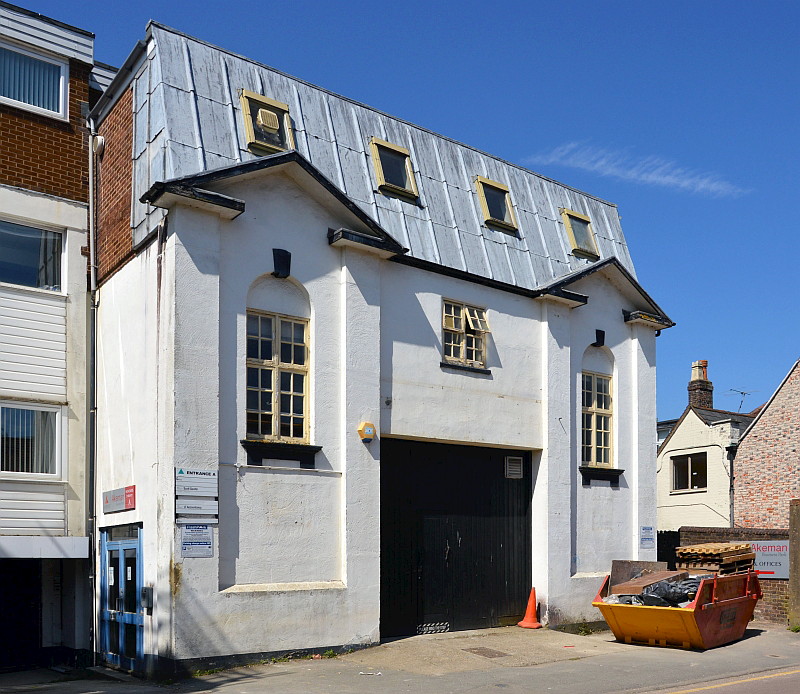
The GAIETY today - the mansard roof above the gables
was added
and the steps leading up to the pay kiosk and cinema entrance
removed
when the premises became William Batey’s
engineering works.
――――◊――――
THE REGAL
When Smith’s Cinemas appeared on the scene in June/July 1936, the
new REGAL must have been well in the course of construction, so it is difficult to believe that Smith’s were
unaware of this emerging competitor. Just as the GEM had been put out of business some
years earlier by a better-appointed competitor, it was now the turn
of the GAIETY to become the underdog and the REGAL soon became
Tring’s sole picture house. Indeed, looking back at events, it is
surprising that Smith’s Cinemas and later owners saw sufficient
potential to invest in improving an older, smaller building in a
town insufficiently large to support two cinemas; money was probably
lost in the venture.
The building that was to become the REGAL first appears in a report
of a town council meeting held in December 1935, when the Surveyor submitted plans
for a cinema that had already been
considered by the Building Committee. He informed
the Council that the proposed cinema was to be erected on an
empty site on the Aylesbury side of the Church House in Western
Road. By August, construction of the new building was
sufficiently advanced for its owners to
announce that the cinema would open in October.
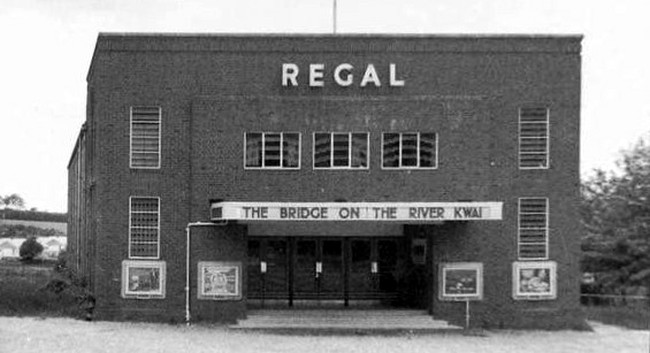
The REGAL shortly before closure in 1958.
“Tring’s new, ultra-modern, luxury cinema, THE REGAL, in the Western
Road, will be formally opened to the public next Thursday [10th
September], with a
matinee at 2.15 p.m.
Capable of seating 500 people, spaciously and in the comfort usually
experienced in a well-appointed lounge, it represents in its
architecture, equipment and appointments the very best that is being
offered to the public in the world of popular entertainment. The
cinema is absolutely fire-proof.
Constructed in brick, its imposing appearance is enhanced by the
magnificent foyer, 24 feet by 35 feet, with its panelling and
fittings of mahogany. The auditorium, 80 feet in length and 54
feet in width, in modern style, is equally striking in its design,
colour scheme and general arrangements for the reception and
accommodation of the public. The colour scheme is carried out
in peach and gold, the upholstery being of harmonising colour, and
the concealed lighting in roof and wall is ingenious, artistic and
extremely effective. Heating is by a central hot water system,
and the ventilation on the most approved lines. Car parking
accommodation has been provided.
The entertainment value offered by this new addition to the social
life of Tring promises to be unsurpassingly good, as good as the
building itself. The latest types of Simplex projector and the
British Talking Pictures Sound System have been installed.
There will be continuous performances each day, from 5.15 p.m.,
enabling the full programme to be given twice; and matinees in
addition on Wednesday and Saturday afternoons.
The undertaking has the obvious advantage of Mr. R. Fort, of
Reading, as managing director. Mr. Fort is well known in the
cinema world as the builder and promoter of REGAL cinemas in various
parts of the country. He was responsible for the REGAL’s at
Bicester and Abington, and is erecting another cinema of the same
name at Princes Risborough.
In Mr. A. C. Powell, the resident manager of the new REGAL Cinema at
Tring, the promoters have made a wise and happy selection. By
virtue of his previous residence in Tring, Mr. Powell is well known
and deservedly popular with local audiences, and he has a wide
experience of cinema organisation and management. Mr. Powell
was formerly a scenic artist, and the Vale Players have enjoyed the
advantage of his talent in that direction.”
Bucks Herald 18th September 1936
The REGAL was one of a number of cinemas of that name, all built to
similar designs drawn up by the Birmingham-based architect Harold Seymour
Scott. They had wide, plain brick frontages with attractive
single-floor auditoria behind. The Tring REGAL was built using
local labour by G. Elvin and Sons of Birmingham at a cost of
£12,000. With 514 seats it was one of the smallest cinemas in the
group. |

Opening programme 10th September 1936
|
 |
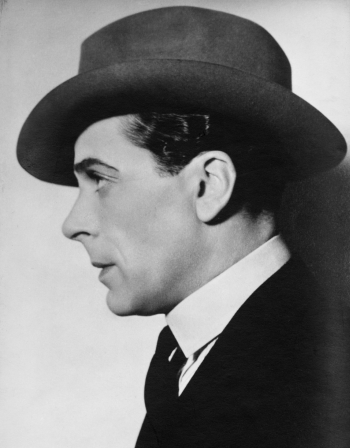 |
|
Fay Wray
was a Canadian-American actress whose acting career spanned
nearly six decades. She attained international recognition as
an actress in horror films ― most
notably as Ann Darrow in the 1933 film King Kong
― and as such was dubbed one of the
first “scream queens”. |
Jack Buchanan
was a Scottish theatre and film actor, singer, dancer,
producer and director. His Hollywood films include the 1953 musical
The Band Wagon in which he appeared with Fred Astaire and Cyd
Charisse. Buchanan frequently produced his own shows and was also
heavily involved in the more commercial side of British
show-business. |
|
OPENING PERFORMANCE AT THE NEW CINEMA
THE COMFORTS OF “THE REGAL”
The opening performance at the Regal Cinema took place on Thursday
afternoon of last week, when among the guests were Sir John Davidson,
M.P., the Member for the Division, and Lady Davidson, and members of
the Tring Council.
The many patrons were all thoroughly appreciative of the luxuries of
the new cinema, the carpets, the up-to-date and comfortable seating
and the effective modern lighting effects.
The performance opened with the playing of the National Anthem. Two
amusing comedies were the chief feature of the programme. “The
Affair of Susan,” in which Zasu Pitts and Hugh O’Connell appear, and
Jack Buchanan’s British film “Come Out of the Pantry,” in which he
is supported by Fay Wray. The programme was completed by a Mex
Fleischer colour cartoon, “An Elephant Never Forgets,” and the
Paramount Sound News.
The projection and sound-reproducing equipment proved to be
excellent, as was to be expected, in view of the fact that the latest
type of apparatus has been installed. The enjoyment of the Regal
patrons will be much enhanced by this, by the pleasant surroundings
and the taste with which the cinema has been erected and decorated.
Bucks Herald 18th September 1936
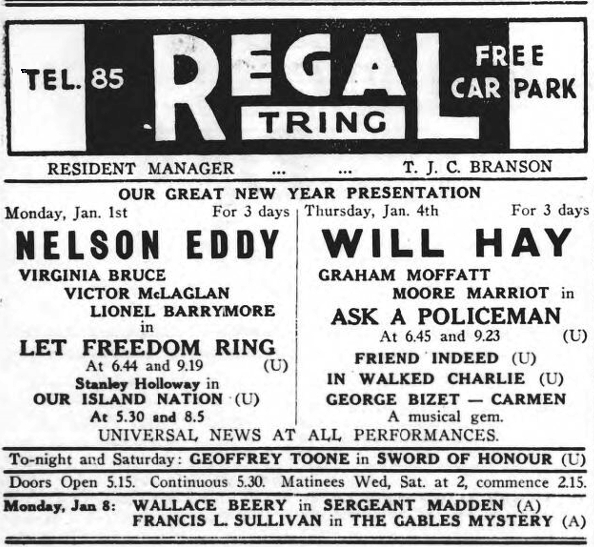
|
“The Thursday, Friday
and Saturday feature is ‘Ask a Policeman,’ in which Will
Hay leads an imposing cast, including his two familiar
‘helpers,’ Graham Moffatt and Moore Mariott. Will
Hay is seen as Sergeant Dudfoot, a bobby with a
condescending manner, getting himself, ‘fat-boy’ Albert
and ‘decrepit’ Harbottle into no end of hot water with
his meddling ways.”
Bucks Herald 29th December 1939 |

Will Hay, Moore Mariott and Graham Moffatt
in probably the most successful of their collaborations, Oh Mr.
Porter (1937).
In common with other cinemas the REGAL did good business during the
war thanks to the American forces stationed at Marsworth, while many
the town’s residents went every week regardless of the programme,
the News Reel being a particular wartime attraction.
However, The Sunday Entertainments Act (1932) prevented
cinemas opening on Sundays unless the majority of the electorate
expressed a wish for Sunday opening, but it wasn’t until the 14th
June, 1947, that Tring had a vote on Sunday Cinema.
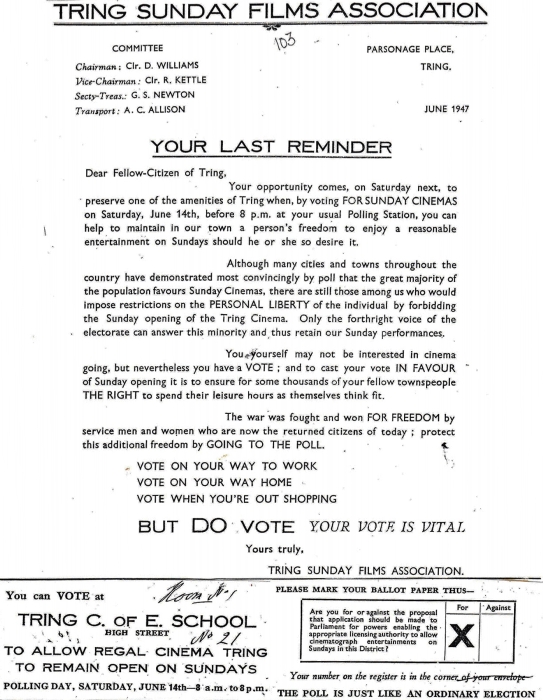
Following a week of spirited propaganda a large number of the
REGAL’s patrons turned out to use their vote and raise their
opinions. The result was an overwhelming vote in favour of
Sunday opening – 1,262 voted for,
358 against on a 50% electoral turnout. And so the REGAL began
to offer Sunday programmes.
The REGAL became part of the Mayfair circuit
when it was formed in the early 1940s. Around 1943 it passed to the large ABC
circuit along with all the other Mayfair cinemas, making
it the first ABC outlet in Hertfordshire. The REGAL was not,
however, regarded with any great pride by its new owners.
Barring [9] took away the best films until three weeks after they had
played Aylesbury and Hemel Hempstead and by 1958, when all matinées
had been cut (it opened daily around 4.30pm), it was a long-standing
loss-maker and overdue for closure.
|
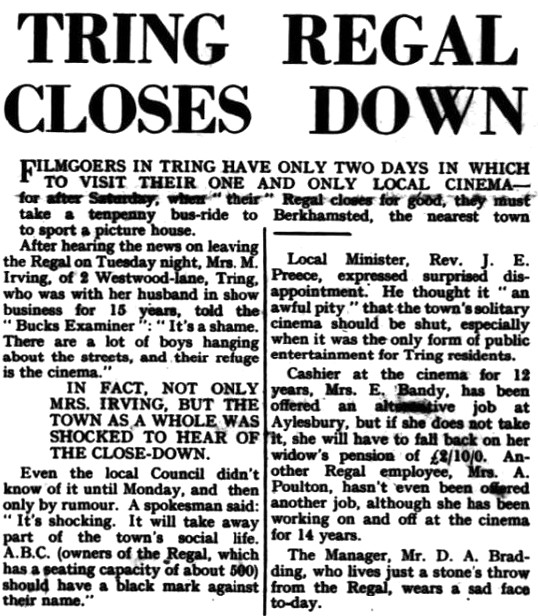 |
|
Bucks Examiner, 14th February 1958. |
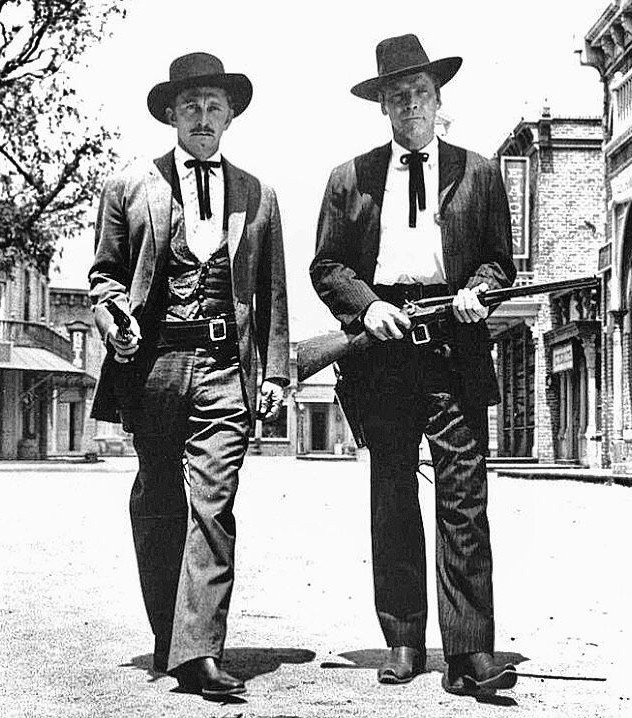
Kirk Douglas and Burt Lancaster
in the 1955 Western Gunfight at the OK Coral.
The REGAL closed at very short notice on Saturday the 15th February
1958 after concluding a three-day run of Gunfight at the OK
Corral supported by At the Stroke of Nine. The high
rate of Entertainment Tax [6] was blamed.
This did not deter an independent operator from taking a lease and
re-opening the cinema on the 6th April 1958 but this was in vain and
the REGAL was forced to close again on the 19th March 1960.
ABC disposed of the property on the 20th September 1961, but this
was not to be the last time that the REGAL was to open its doors to
a Tring audience.
THE MASQUE THEATRE
In August 1965 it was announced that REGAL had been leased by a new
company to be called The Masque Theatre Ltd. and that the building
was in the process of conversion into a theatre. The company
was headed by Elizabeth Short (21) of Stoke Mandeville, Deborah
Johnson (20) and Ian Parker (21). Miss Short, had recently
been appointed assistant conductor of the BBC Scottish Orchestra,
but had resigned to lead this exciting
venture.
Fortnightly repertory planned
The announcement last week that the REGAL cinema, Tring, had been
leased to a new company – The
Masque Theatre – must have brought
joy to the hearts of Tring theatre enthusiasts.
Among the three young people who head the new company is 20-year-old
Deborah Johnson.
Miss Johnson, who recently played the lead in the very successful
charity show “Carousel” in Aylesbury, has turned down a major
professional offer – the soprano
lead in “A Funny Thing Happened On The Way To The Forum” at the
Strand Theatre.
The rest of the company, the number 20, is in the process of
recruitment and will gradually take over from the large team of
voluntary helpers who at the moment are performing the cleaning and
redecorating.
It is planned to perform a fortnightly repertory of musicals, plays,
opera, revues and concerts. The Masque will also be available for
use by local amateur societies, and other visiting companies will be
accommodated from time to time. Already booked is “The Pedestrians”
revue, a by-product of “Beyond the Fringe”, who are performing in
this year’s Edinburgh Festival.
What happened to The Pedestrians, if in fact it took place,
isn’t recorded in the press, but the theatre’s inaugural show, the
new musical Heidi, is.
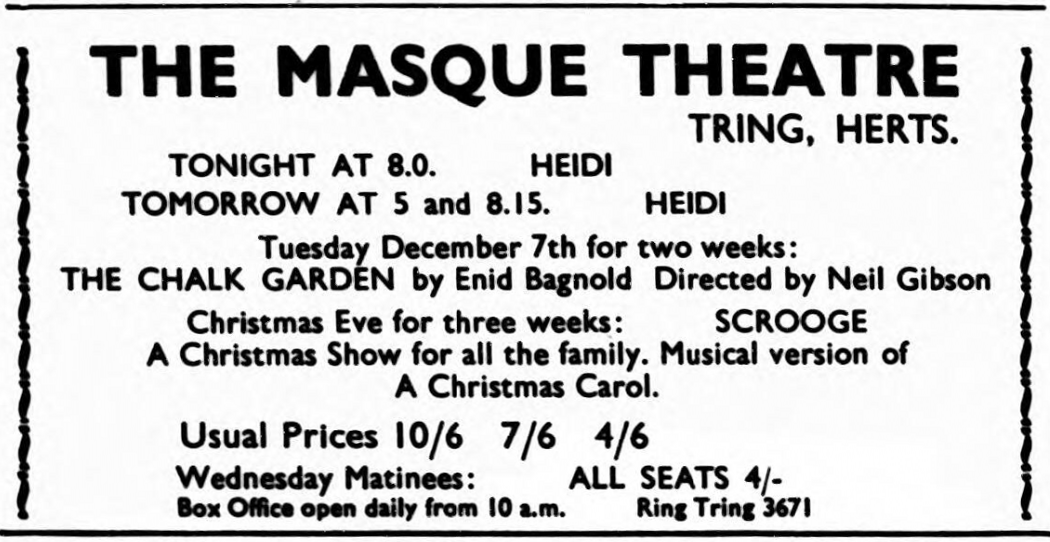
Unhappy start for the Masque Theatre
Enthusiasm, optimism and drive are admirable qualities in the
young. Of necessity they lack experience, but this is no fault
of theirs. But it can happen that without experience, optimism
and enthusiasm can be misplaced, and a project worthy of praise
backfires in the faces of the very people whose hard work and
enthusiasm brought it into being.
This is what happened at the much-heralded first ‘First Night’ at
the Masque Theatre, Tring, on Saturday, when the world premiere of a
musical based on the book ‘Heidi’ was due to be staged before an
invited audience.
Despite the wet and cold weather the audience was there in force,
and included such well-known figures as Bernard Delfont, Dorian
Williams, Norman Shelley and singer David Hughes. The mayors
of Watford and Tring, with several other civic dignitaries were
present, together with representatives of radio and television.
In the presence of this star-studded assembly it was most
unfortunate that the one thing missing was what they had come to see
– the world premier of the musical
“Heidi”!
TWO PIANOS
Dorian Williams introduced David Hughes, who declared the theatre
open. It then transpired that the stage had arrived only that
afternoon, leaving insufficient time for it to be erected properly,
and for this reason the show could not be put on in its entirety.
As an alternative the audience was invited to listen to the musical
numbers sung to the accompaniment of two pianos and a drum, with a
linking narrative by the indefatigable Elizabeth Short.
Not only is Miss Short indefatigable, she also shows an
incredible versatility. She is a director, and one of the
prime movers of the Masque Theatre scheme, is producer of the show,
wrote the music for it, and finally appeared as one of the two
pianists who formed the ‘orchestra’. Her co-director and
associate prime-mover, Deborah Johnson, played the title role of the
grown-up Heidi, while Susan Craddock was a charming and intelligent
young Heidi.
The transformation of the building from a disused cinema to a
theatre had been started only seven weeks before, with just three
weeks of rehearsals. the sad result was an under-rehearsed cast
playing in an uncompleted building.
DELIVERING GOODS
The enthusiasm and energy (and there must have been plenty of both)
which went into the preparation for Saturday’s opening would have
had a greater reward had they been tempered with a practical
appreciation of the problems involved in getting firms to deliver
goods on time, and of the difficulties in training young children to
dance and sing, let alone act. Another two weeks would have
made all the difference in the world.
I find it impossible to give an adequate review merely on the
strength of a few songs out of their context. Even so, my own
opinion was that the musical score was uninspired, and that the main
number ‘I wish today would never end’ expressed a sentiment few of
the audience would have shared.
Still, the Masque Theatre is a brave and bold venture and will no
doubt survive this ‘half-cock’ start. Let us hope that by the time ‘The Chalk Garden’ starts its run on December 7th. the company will
be on firmer ground - and on a less precarious stage.
Buckinghamshire Examiner, 26th November 1965
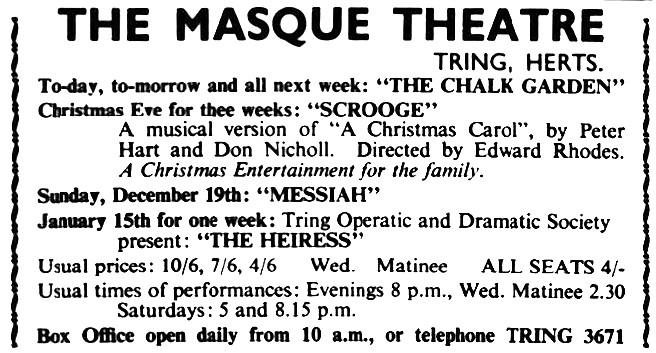
Buckinghamshire Examiner, 10th
December 1965
On commenting on the forthcoming production of The Chalk Garden,
Elizabeth Short, co-director, said she was confident of success.
“Whereas Heidi was born out of chaos this play has a
background of well-organised rehearsals.” To what extent
The Chalk Garden was a success isn’t recorded.
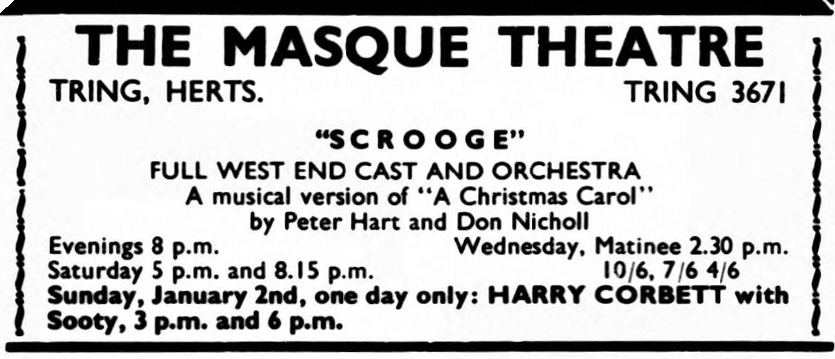
Buckinghamshire Examiner, 31st December 1965
Next came the musical Scrooge.
‘SCROOGE’ COULD NOT SAVE ‘THE MASQUE’
The Masque Theatre in Tring, born five weeks ago, has slowly had
its life blood drained away by financial difficulty and, following
an appearance on Sunday of TV’s children’s favourite, Harry Corbett
and his puppet “Sooty”, the Masque will ring down the curtain for
the last time and complete a sad episode for its owners, Miss
Elizabeth Short and a young American actress, Miss Deborah Johnson.
The closure of the former Tring cinema stems directly from an
intervention by Equity, the official actors’ and actresses’ union,
who stepped forward when the cast of the current Christmas
production “Scrooge” were not paid their week’s salaries.
The short run of “Scrooge” ends on Saturday after a history of
financial bad luck. It means a pile of debts for Miss Short, who
recently gave up her job as an assistant conductor with the B.B.C.
Scottish Orchestra, and a giant-sized headache for her partner,
20-year-old American Deborah Johnson, who helped raise the £7,000
required to start their bold project.
Misses Short and Johnson rented the disused cinema five weeks ago
and converted it into the Masque Theatre. However, despite
imaginative productions, the cast almost continually played to a
near-empty hall and the crisis began.
COMPLETE GAMBLE
Said Miss Short last week: “The future of the company is now a
complete gamble. If Scrooge folds up on us, the company itself
will go into liquidation. It’s all very sad.”
However, the poor audiences affected the Christmas production and
the owners were presented with a major task in raising over £300 to
pay their 35-strong cast. Fortunately a bumper matinee raised
the cash to pay salaries after Equity threatened to take action and
close the show.
Following the pay-out, Equity consented to the show running until
the end of the week, but a proviso they made was that an Equity
official be paid one-eighth of each actor’s wage.
Said electrician-cum-Press officer, 22-year old Patrick Gillan: “We
have been placed in a dilemma by Equity's demand for a £350 deposit
to guarantee the cast’s wages if the show flops. We did manage to
raise that amount, but have been faced with the problem of paying
last week's wages.
“After a frantic week-end,” said Mr. Gillan, “we managed to scrape
up the money, but it is true that the company is financially very
bad, but we hope Scrooge will pull us through.”
Now Misses Short and Johnson have decided to call it a day. For Miss
Short it was a bitter decision and the only comment she would make
was: “We were promised a lot of financial backing which has not
materialised.”
Buckinghamshire Examiner, 31st December 1965
And so the REGAL’s career as a live theatre terminated after a few
shows with the scenery of the last production left in situ.
And its story as Tring’s place of
entertainment was to end on a further sad note:
LONDON GAZETTE, 22nd March 1966
THE BANKRUPTCY ACTS, 1914 AND 1926 RECEIVING ORDERS
FIRST MEETINGS AND PUBLIC EXAMINATIONS
JOHNSON, Deborah Ann (spinster), ACTRESS, 15, Randolph Road, London,
W.9, formerly of 211, Wendover Road, Aylesbury, Bucks, and lately
carrying on business with another under the style of “The Masque
Theatre”, Western Road, Tring, Herts. Court—AYLESBURY. No. of
Matter—7 of 1966. Date of Order—7th March, 1966. Date of Filing
Petition—7th March, 1966.
SHORT, Elizabeth Jane (spinster), MUSICIAN, of 211, Wendover Road,
Aylesbury, Bucks, and lately carrying on business with another under
the style of “The Masque Theatre”, Western Road, Tring, Herts.
Court—AYLESBURY. No. of Matter—6 of 1966. Date of Order—7th March,
1966. Date of Filing Petition—7th March, 1966.
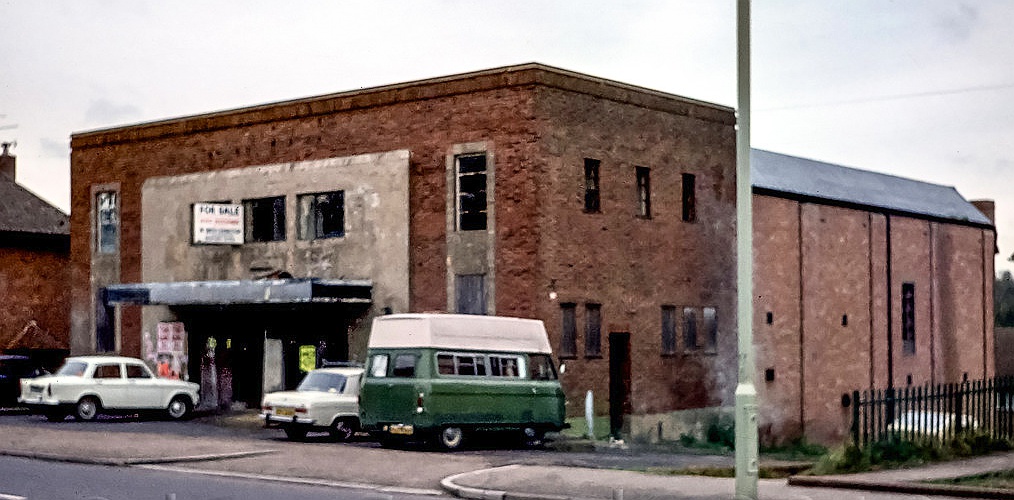
The REGAL for sale in 1975
(Courtesy of
Stagedoor)
Seventeen
different planning applications were made for the REGAL site before the
building was demolished in late 1978/early 1979 — permissions had
sometimes been granted but not put into effect. Ten flats, named Regal Court
(the REGAL at Bicester was likewise replaced by a block of flats
with that name) were eventually built on the site.
――――◊――――
TRING’S POP-UP COMMUNITY CINEMA

TRING
CINEMA
Since August 2015, Tring and the surrounding villages have been
served by a pop-up community cinema. The Cinema was established as a
venture between ‘Tring Together’ and ‘Tring Design’ with the aim of
returning ― after a long absence
― a cinema to Tring, thereby
enriching the cultural life of the town.
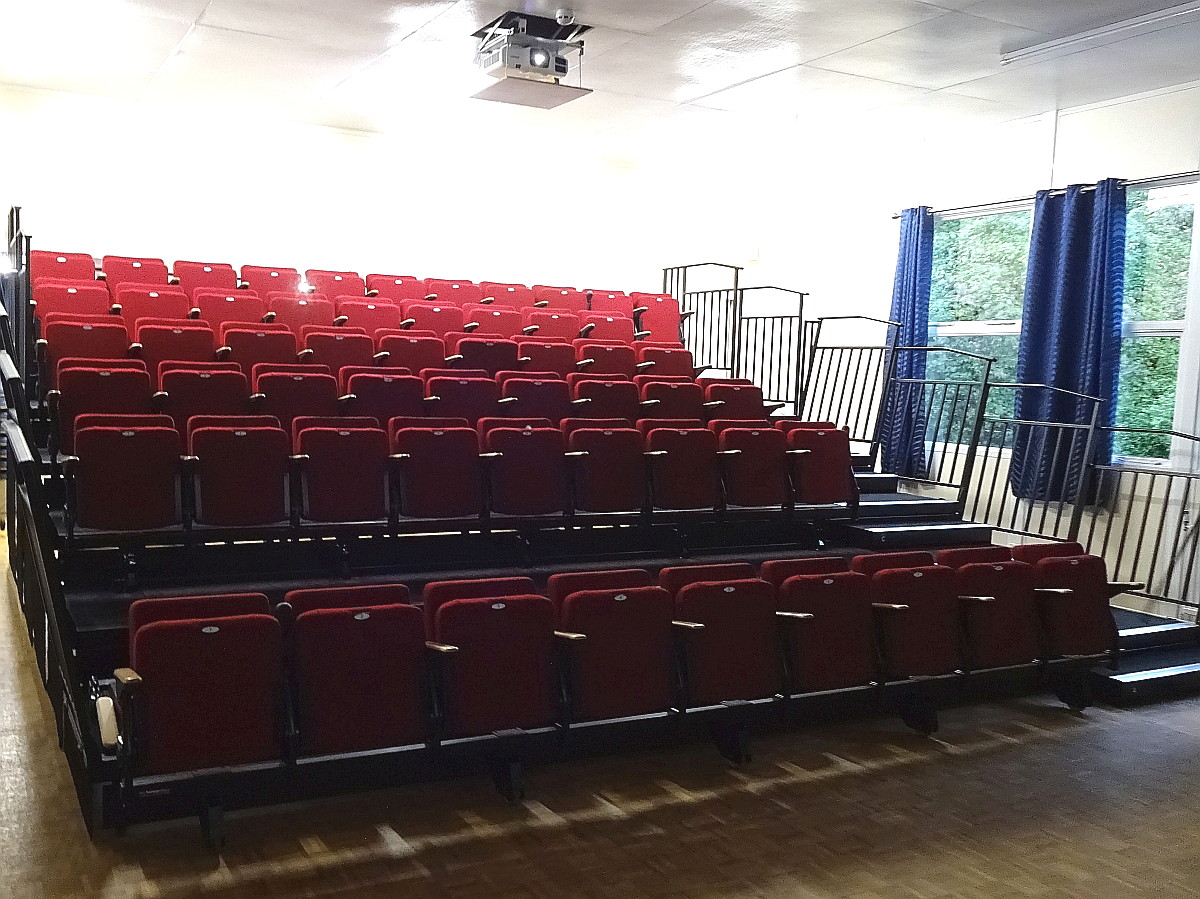
Above, new tiered seating installed in the auditorium together
with the drop-down projector.
Below, the new drop-down screen and some of the surround-sound
speakers.
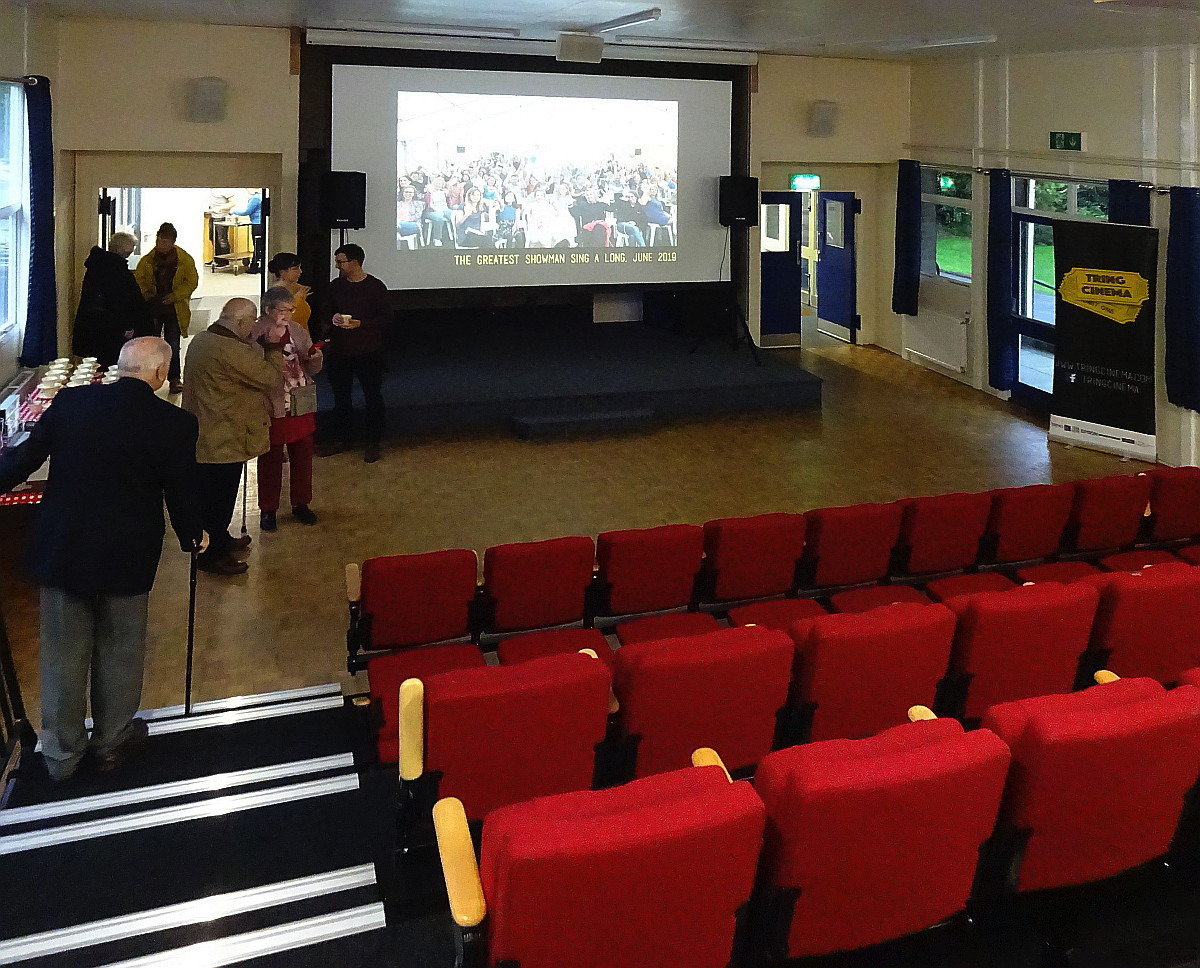
Tring Cinema’s first event was an open air showing of Grease
on a fantastic, self-built 5m x 2.5m wide screen. Epson
provided a projector and Tring Brewery a 200W sound system so that
the Cinema is able to offer the full movie experience. Due to
the generous sponsorship received from local businesses and the
Tring Arts Trust, Tring Cinema has been able to transform the Nora
Grace Community Hall into a cinema in which films are shown once a
month during the colder weather, while the Cinema is moved under the
stars in the summer. Films are a mix of well-loved classics and
newer releases.
――――◊――――
FOOTNOTES
1. The Projectionist. Between
approximately 1905 and 1915, two factors combined to transform the
role of the projectionist into a separate job with a specific
profile of skills and training. Following several major fires
during cinema’s first decade, concerns over the flammability of
nitrate film resulted in the increasing regulation of the film
exhibition industry, including the requirement that projectors be
housed in fireproof booths segregated from the auditorium. In
the United Kingdom, for example, this requirement was introduced in
the Cinematograph Act 1909, which effectively prevented the
projectionist from additionally carrying out a public-facing role.
The
legal right to act as a projectionist in a public movie theatre was,
and to some extent remains, regulated, to varying degrees in
different jurisdictions. In some, projectionists were required
to be licensed by local or central government, which sometimes
required them to undergo assessments or sit examinations.
Trade union-based regulation of the profession was also widespread
in some jurisdictions, in which the licensing of projectionists was
incorporated into collective bargaining agreements between employers
and unions. In the United States, projectionists were
sometimes ‘pooled out’ to theatre companies via their union.
Closed shop working by projectionists was common in British cinema
chains until the early 1980s.
The original reason for this
regulation was the necessity for safety precautions for the use of
nitrate prints, and hence the requirement that projectionists should
be formally trained to handle them in order to ensure public safety.
But the formal training and licensing of projectionists continued in
most of the US and Europe well after nitrate had been superseded in
the 1950s, and in a minority of jurisdictions it continues to this
day. Source Wikipedia.
2. Vitagraph Studios, also known as the Vitagraph Company of
America, was a United States motion picture studio. By 1907 it
was the most prolific American film production company, producing
many famous silent films. It was bought by Warner Bros. in
1925. Source Wikipedia.
3. Early film projectors. In
order show a feature-length film without interruption while the
following reel is laced up, two projectors focused on the same
screen were used, with the projectionist ‘changing over’ from one to
the other at the end of each reel.
|
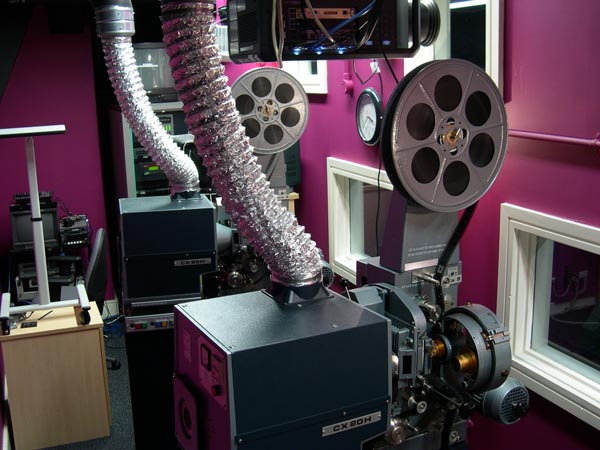 |
|
Two projectors installed in a changeover configuration.
The machine in the background will show the first reel,
at the end of which the projectionist will ‘change over’
to reel 2, which is threaded on the projector in the
foreground. If the procedure is performed correctly, the
audience will be unaware that it has happened. |
2,000 foot ‘double’ reels
were gradually introduced from the early 1930s onwards
(approximately 20 minutes at the standardized sound speed of 24fps).
Until the conversion to sound, electric motors were relatively
uncommon on 35mm theatre projectors: most were hand-cranked by the
projectionist. Contemporary accounts suggest that hand
cranking at a consistent speed took a considerable amount of skill.
Presentation technique also began to include tasks such as operating
auditorium lighting systems (dimmers), curtains (side-tabs) and
masking systems and lantern slide projectors. During the
1920s, movie theatres became larger and projection equipment had to
adapt to this. Limelight illumination was replaced by the
electrically-powered carbon arc lamp, and with the arrival of sound
electric motors were installed to drive projectors (a more constant
speed was required for sound playback than could be achieved by hand
cranking). The operation and basic maintenance of audio
equipment also became part of the projectionist's job following the
introduction of sound. Source Wikipedia.
4. The Cinematograph Act 1909. Was a British Act of
Parliament (repealed in 1985), the first primary legislation
designed specifically to regulate the film industry. The Act
was a consequence of highly unstable nitrate film stock, which had
caused several serious fires. It was intended to ensure that
cinemas were in a suitable physical state to screen films safely by
bringing them under local authority control and requiring them to be
licensed. However, the Act had unforeseen consequences in that
many local authorities stretched the definition of “inflammable
films” to cover not just their physical nature but also the
images they contained, although there is nothing in the Act that
specifically requires this.

The outcome was a crackdown on
controversial films with local authorities threatening cinema owners
with the loss of their licenses even if they had otherwise fully
complied with the Act. The industry reaction led in 1912 to
the establishment of the British Board of Film Censors, an
independent non-government body set up to give uniform film
classification to all films shown in the UK. The BBFC is
funded through the fees paid by film distributors to have their
works rated.
5. Halton Camp Cinema. Very little is known
about the Halton Camp Cinema. According to the Bucks Herald,
“the Government had licensed Darvell to erect a theatre and to
provide amusement for the troops”, although the general public
was also admitted. Besides film shows, the theatre was used by
the military for both Sunday services and lectures - according to
Darvell, “the military authorities used it whenever they thought
fit.”
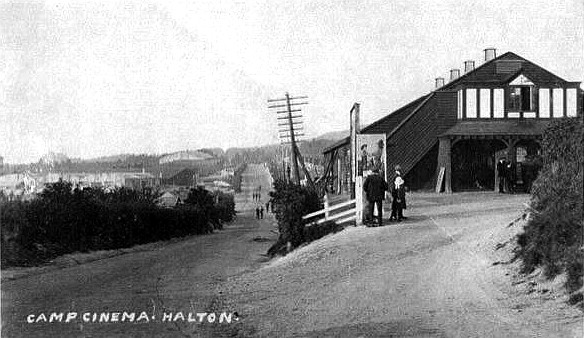
The cinema bears a striking architectural resemblance to Darvell’s
other cinema, THE GEM, at Tring, and might
therefore have been by the same architect. It is known to have
been in operation in May 1915, but when it closed is not known.
Advertisements appeared in May 1925 for bricklayers to work on a new
cinema at Halton Camp, presumably to replace the earlier building. |
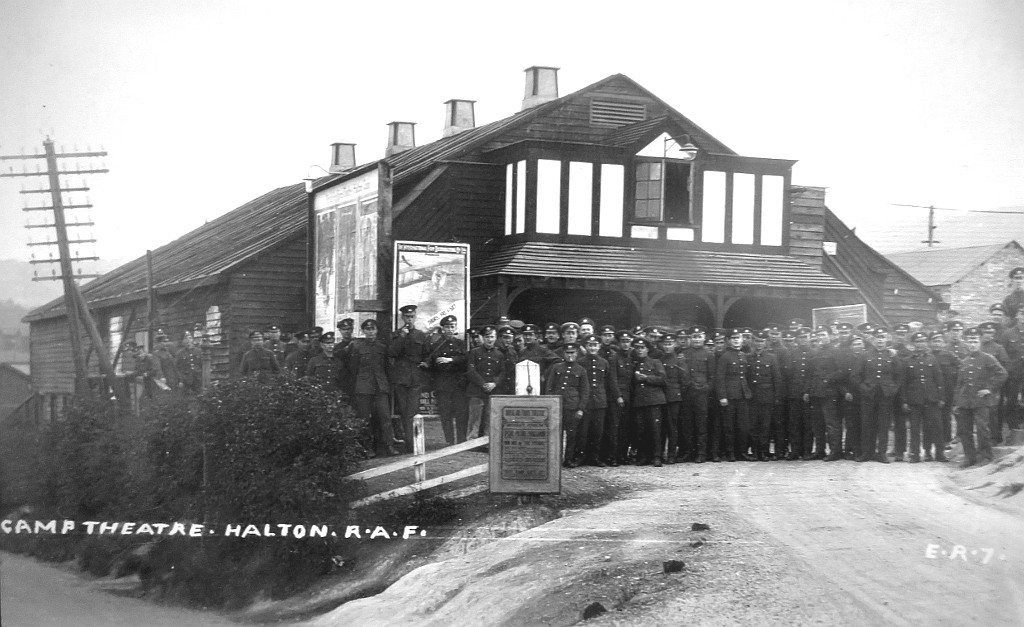
Reference to the
‘RAF’ means that
this pictures was taken in or after 1918.
|
6. Entertainment Tax. Usually referred to as ‘Entertainment
Tax’ and officially as ‘Excise Revenue’, it was a tax on all forms
of entertainment created in 1916 to fund the war effort but
― despite much protest
― not removed until 1960. On
cheaper cinema seats the flat rate of tax represented a high
proportion of the ticket price. Vigorous protests by the
industry led in 1920 to a reduction in the flat rates, nonetheless
the proportion of tax remained high: on a 4½d ticket, the tax was
2d. Because of its stepped rates, by the 1940s the tax on some
popular ticket prices was greater than the net price of the ticket
(e.g., 2s tax on a 1s 10d admission charge). Penalties for
non-payment were hefty: £50 for the exhibitor and £5 for the person
admitted.
The tax ― which applied to
cinemas, theatres, dance halls, sporting events and circuses
― was collected using tax stamps.
These were bought at a Post Office, meaning, in effect, that tax was
paid before revenue was earned, which to cinema managements running
on a shoestring could prove a strain. A stamp was then stuck
to the back of the each admission ticket. When a ticket was
handed to the customer, he or she was shown to their seat and the
ticket torn in half, which cancelled the stamp preventing its reuse.
7. Talkies. Until the late 1920’s, motion pictures were
silent except for the music provided by accompanying musicians with,
perhaps, sound effects (rattling, banging, clashing of swords, etc.)
provided by other cinema staff. The Jazz Singer,
released by Warner Brothers in October 1927, was not the first sound
film in the strictest sense ― in
1926 they released Don Juan, their first feature length film to
include music and various sound effects employing the Vitaphone
system, [8] but no spoken dialogue. The
Jazz Singer, however, is the first feature-length motion picture
to have both a synchronized recorded music score and also
lip-synchronous singing and speech, but in several isolated
sequences. Its release heralded the commercial ascendance of
talkies and ended the silent film era.
While the introduction of sound greatly benefitted the motion
picture industry, talking pictures proved a disaster to others.
They damaged the careers of the many musicians who accompanied
silent movies, while the voices of certain actors proved a difficult
hurdle for many to overcome (an example is parodied in the musical
Singing In The Rain, in which silent film star Lina Lamont is
afflicted by a heavy New York accent and a high-pitched voice).
A heavy accent was a particular problem for some foreign actors.
Sound also influenced audience behaviour. During the silent film
era, it was considered acceptable to talk during a film. Because
people were allowed to voice their responses to the film, a common
bond was forged among the audience with many expressing a common
reply. With talkies, however, audiences concentrated on hearing the
sound, rather than those seated around them.
Within a few years of The Jazz Singer’s release it had become
unthinkable to produce a film without spoken dialogue. For
this reason many silent films were destroyed
― estimates are around 75 percent
― because they were thought to have
little or no value.
8.
Vitaphone. Was a sound film system used for feature films
and nearly 1,000 short subjects made by Warner Bros. and its sister
studio First National from 1926 to 1931. Vitaphone was the
last major analogue sound-on-disc system and the only one which was
widely used and commercially successful. The soundtrack was
not printed on the film itself, but issued separately on gramophone
records. The discs, recorded at 33⅓ rpm (a speed first used
for this system) and typically 16 inches (41 cm) in diameter, would
be played on a turntable physically coupled to the projector motor
while the film was being projected, achieving a frequency response
of 4300 Hz. Many early talkies, such as The Jazz Singer
(1927), used the Vitaphone system.
Source Wikipedia.
9. Barring was the practice whereby
a distributor simply refused to allow one of its films to be shown
in a rival’s cinema. Barring orders specified a radius of x
miles around one of their cinemas inside which the film couldn’t be
shown by a competitor.
Barring is not possible without
“alignment”. Alignment refers to vertical integration
in the film industry and the practice of a distributor favouring its
own chain of cinemas over those of a competitor. In the 1950s and
1960s in the UK the duopoly of Rank (Odeon) and ABPC (ABC) meant
that in many locations there were two circuit cinemas competing for
audiences. Each of the distributors not only favoured their own
films in their own cinemas but also made deals with the Hollywood
studios, aligning a Hollywood studio with their chain. Thus ABC
cinemas showed Warner Brothers and MGM and the other studios went
with Odeon. |
――――◊――――

<>
|
